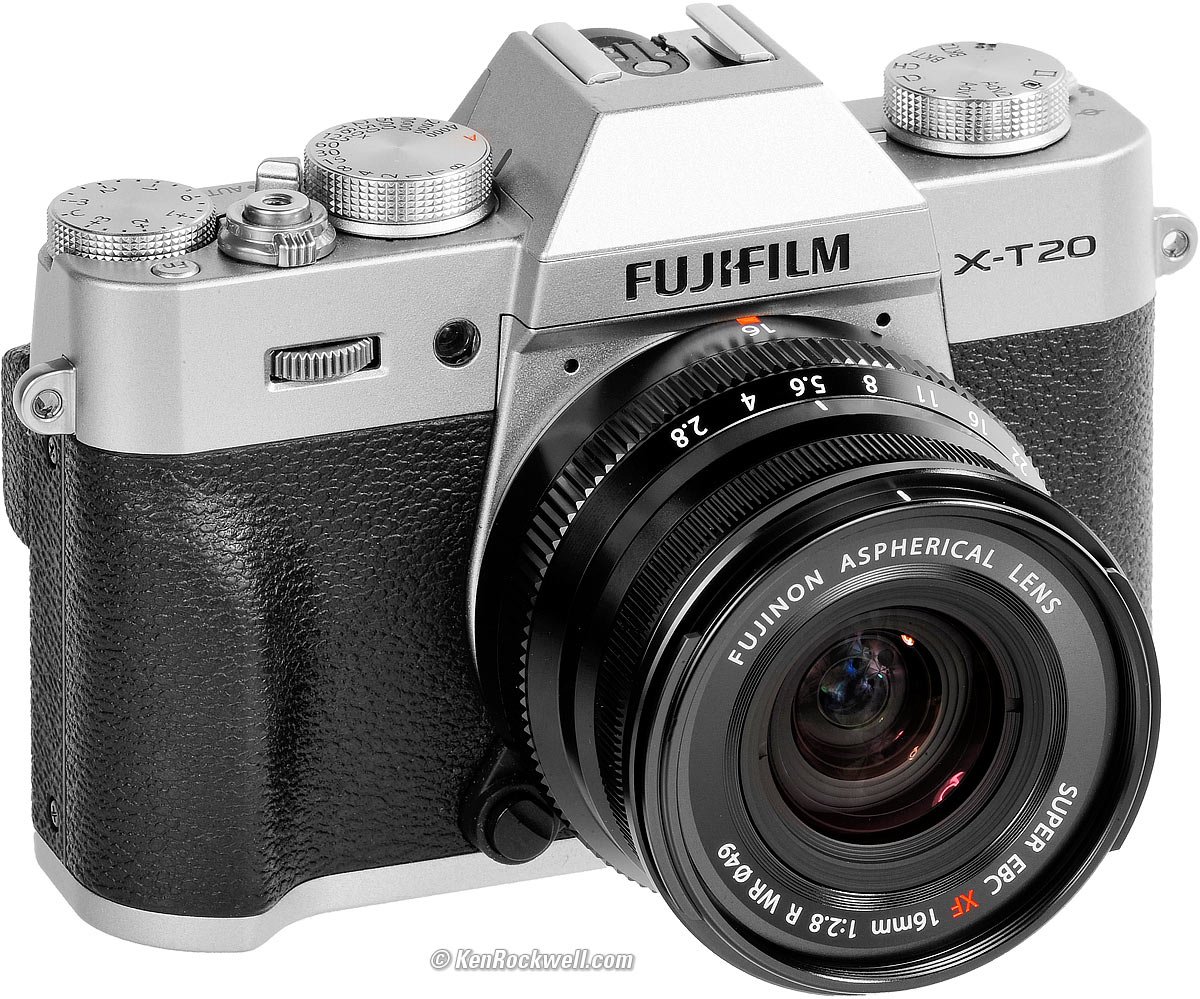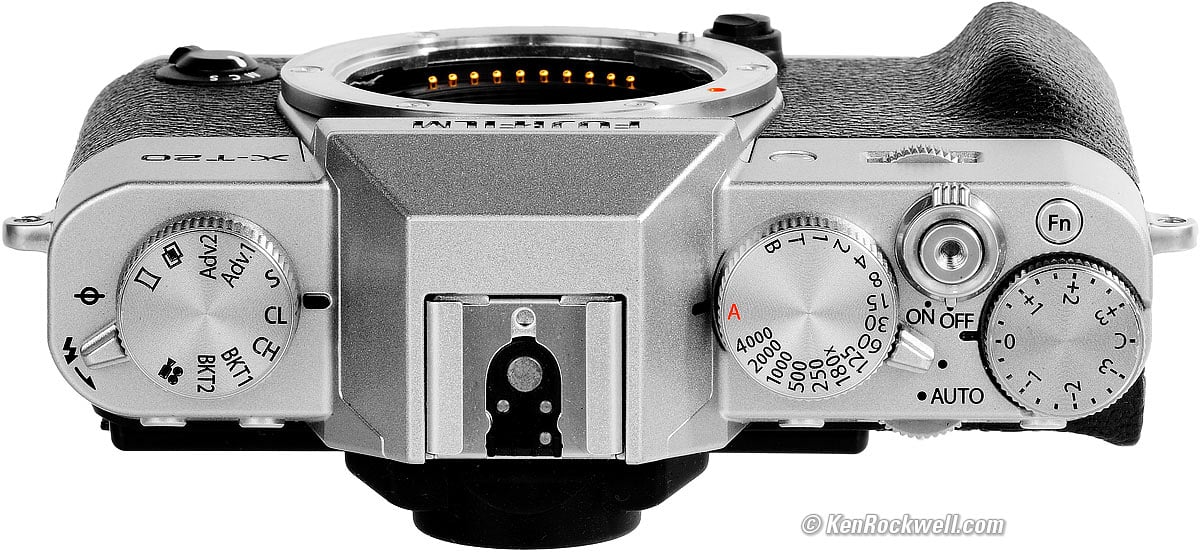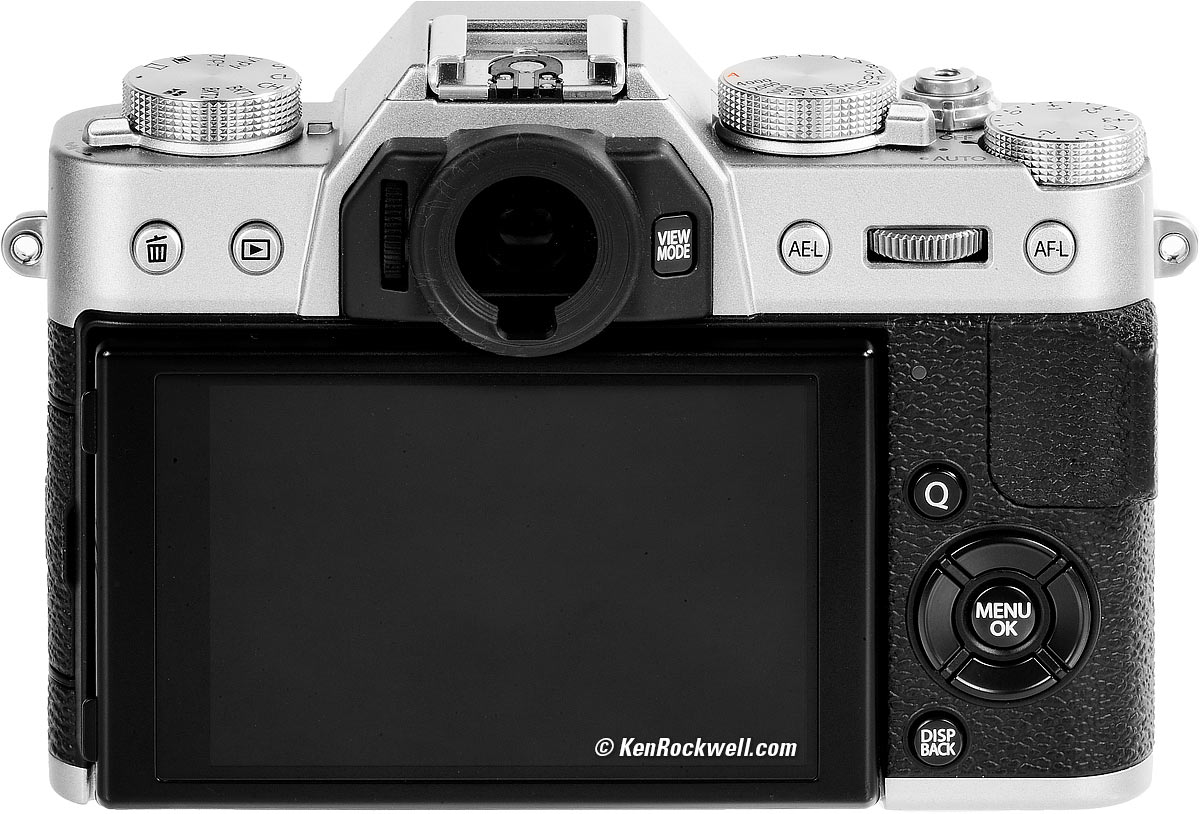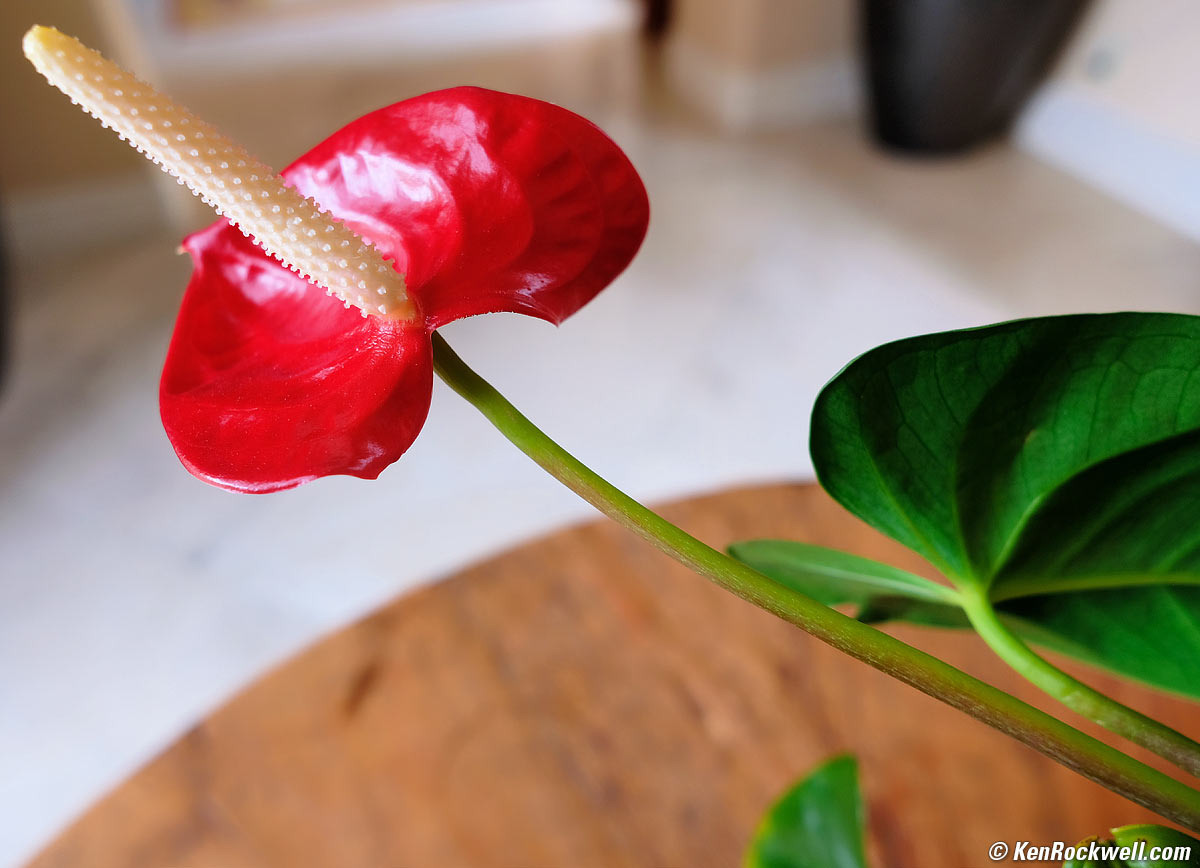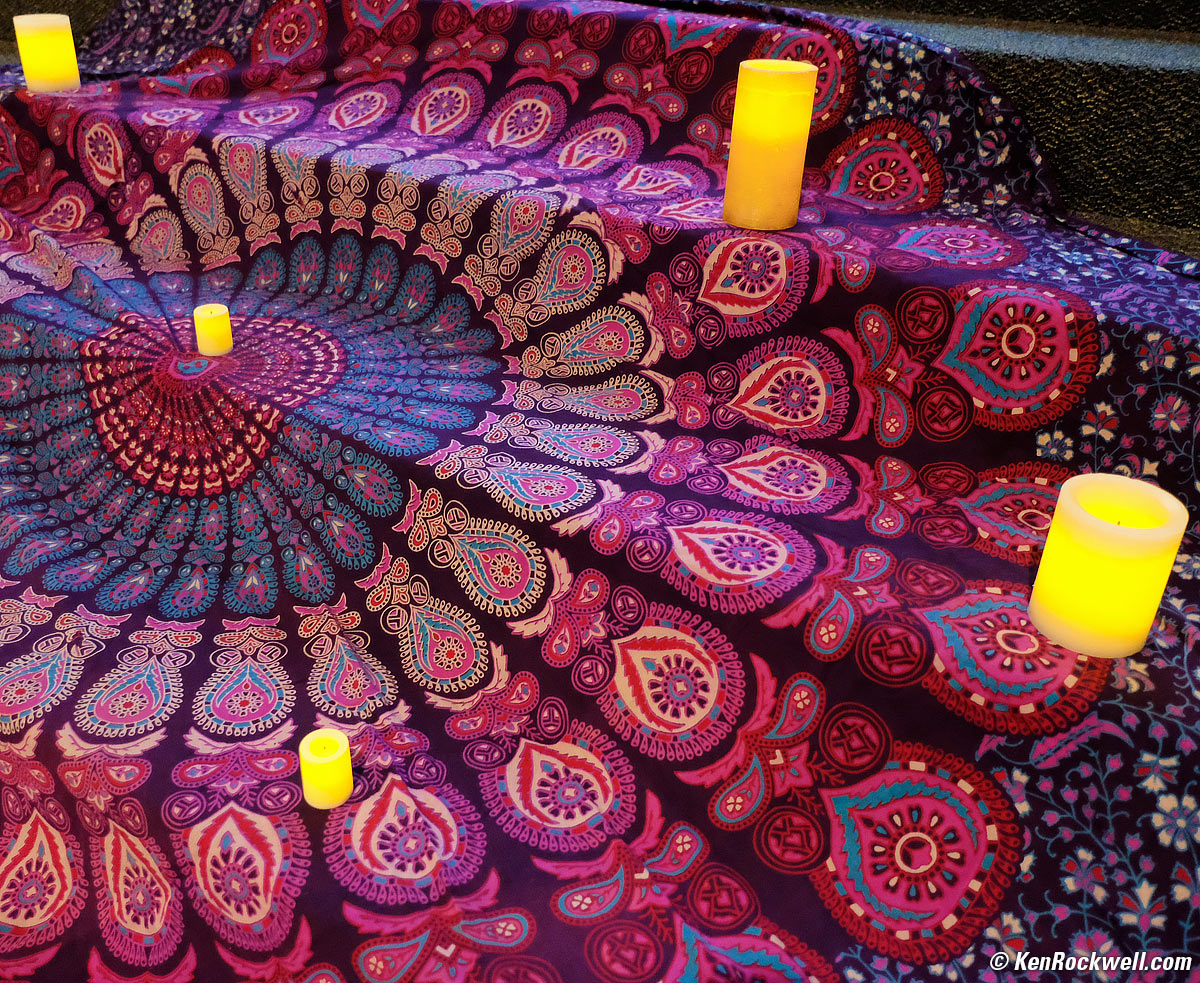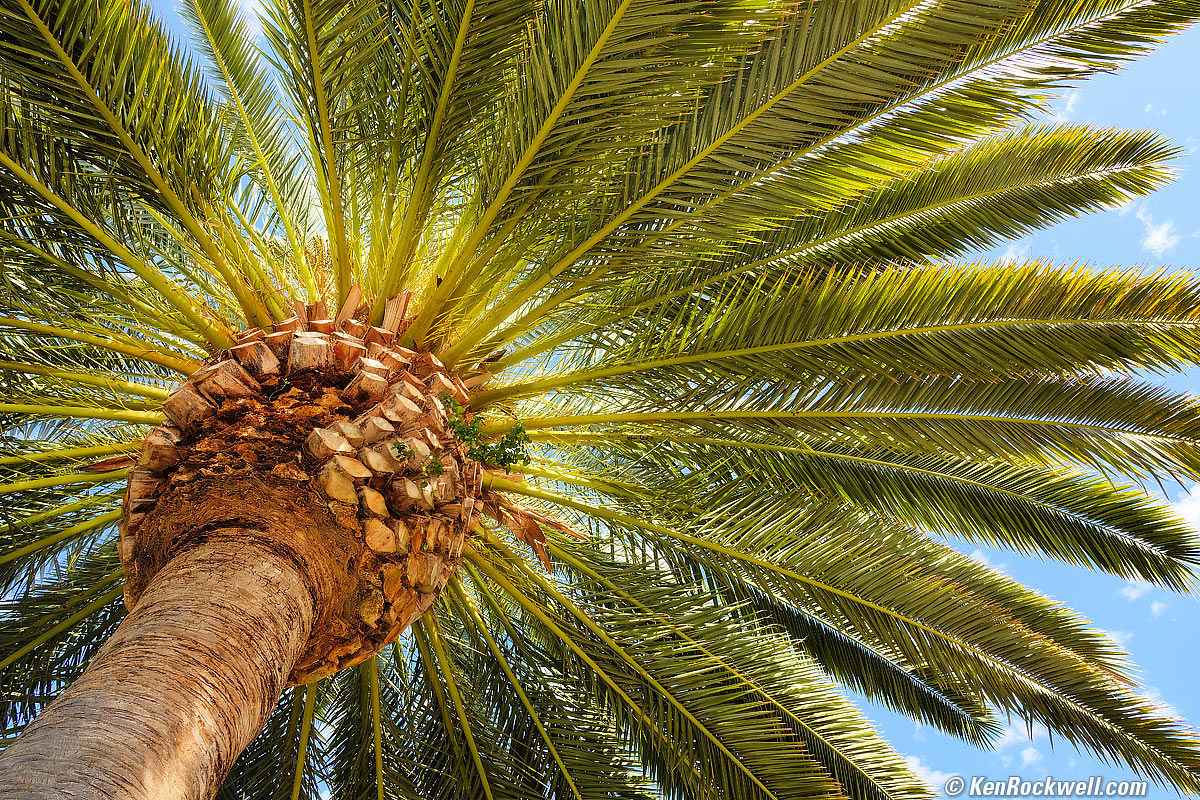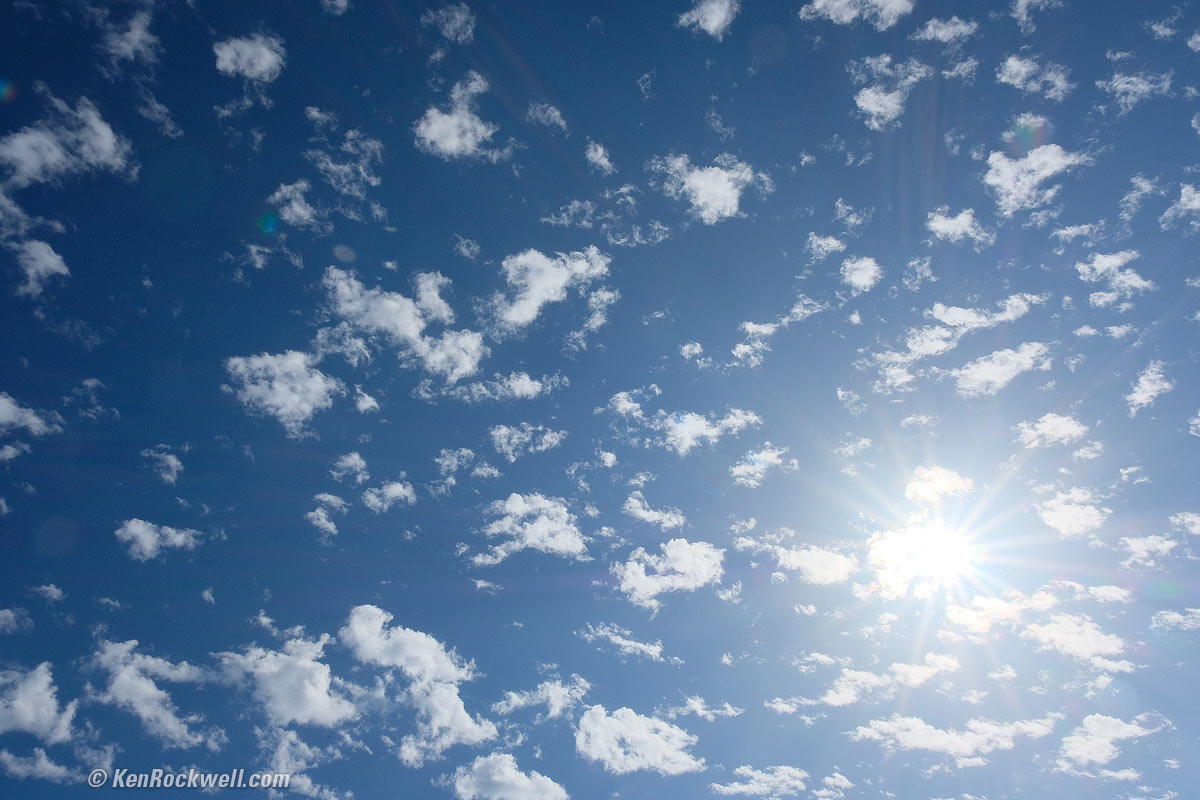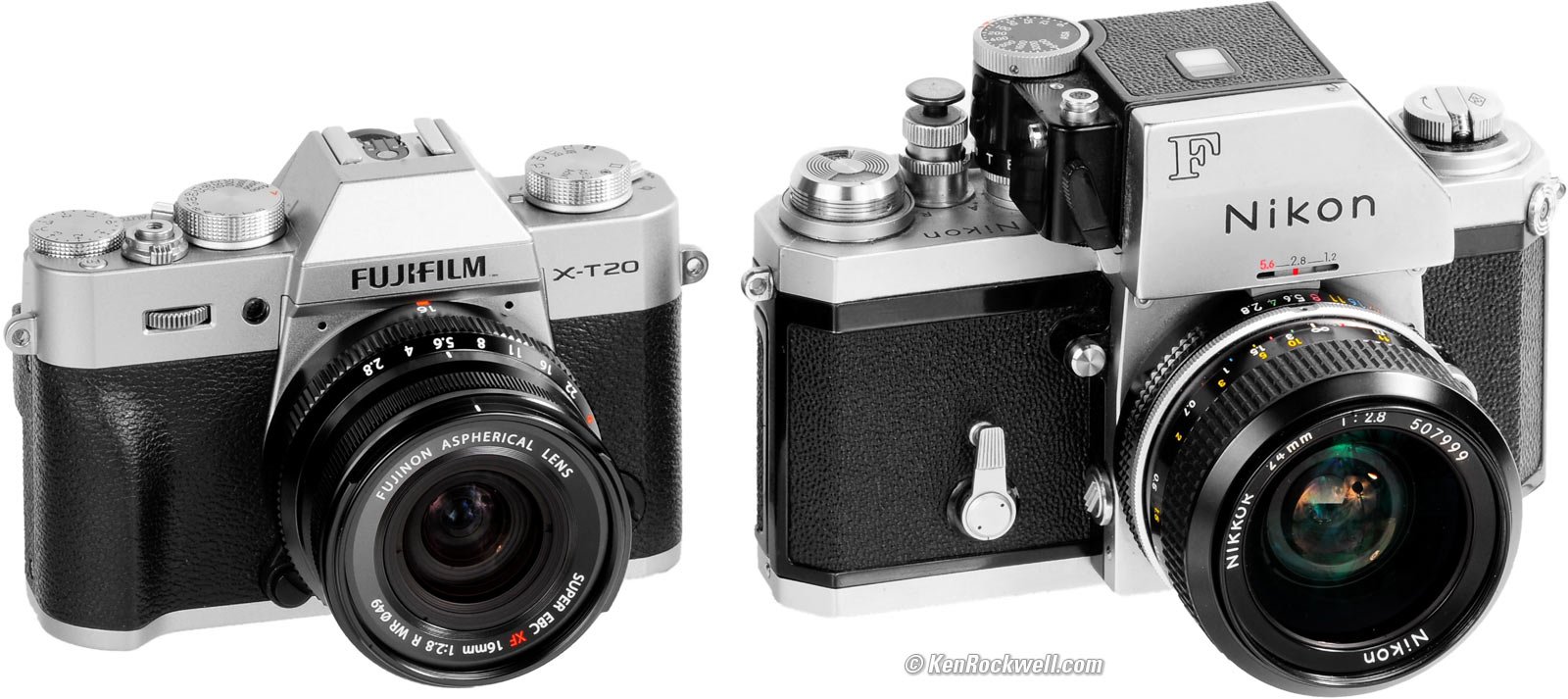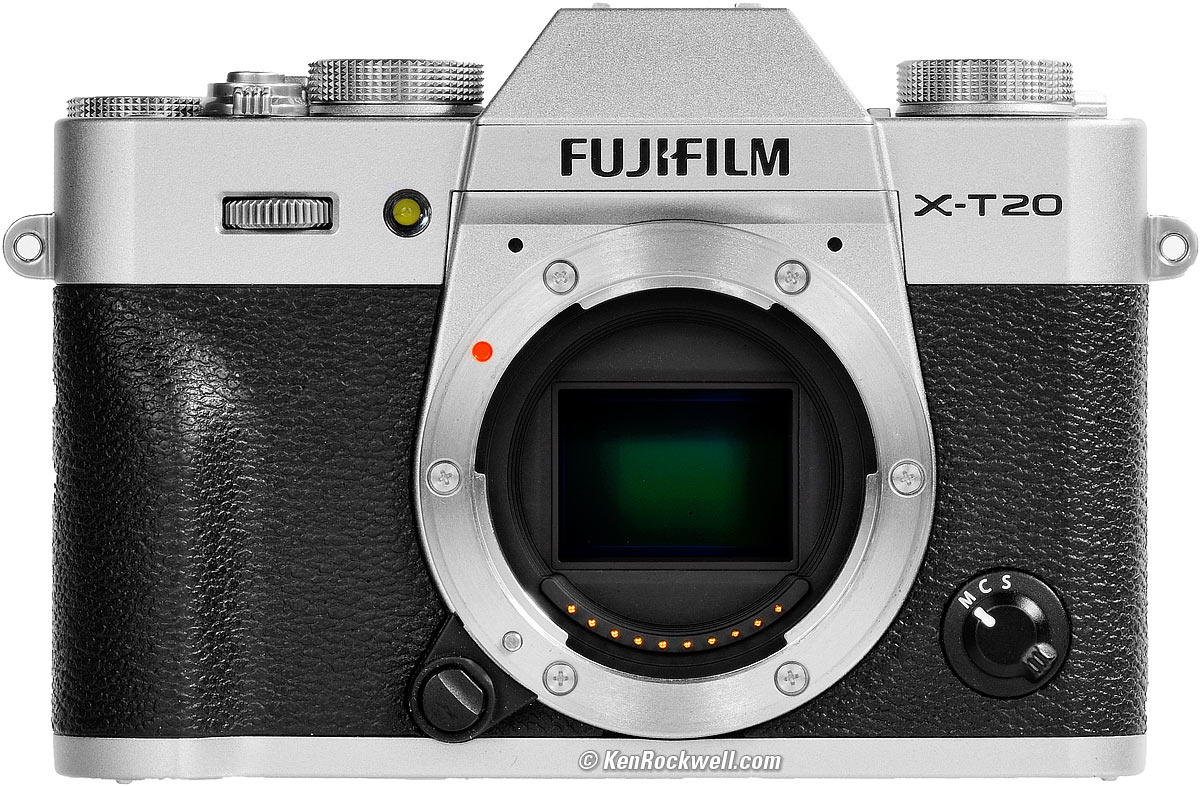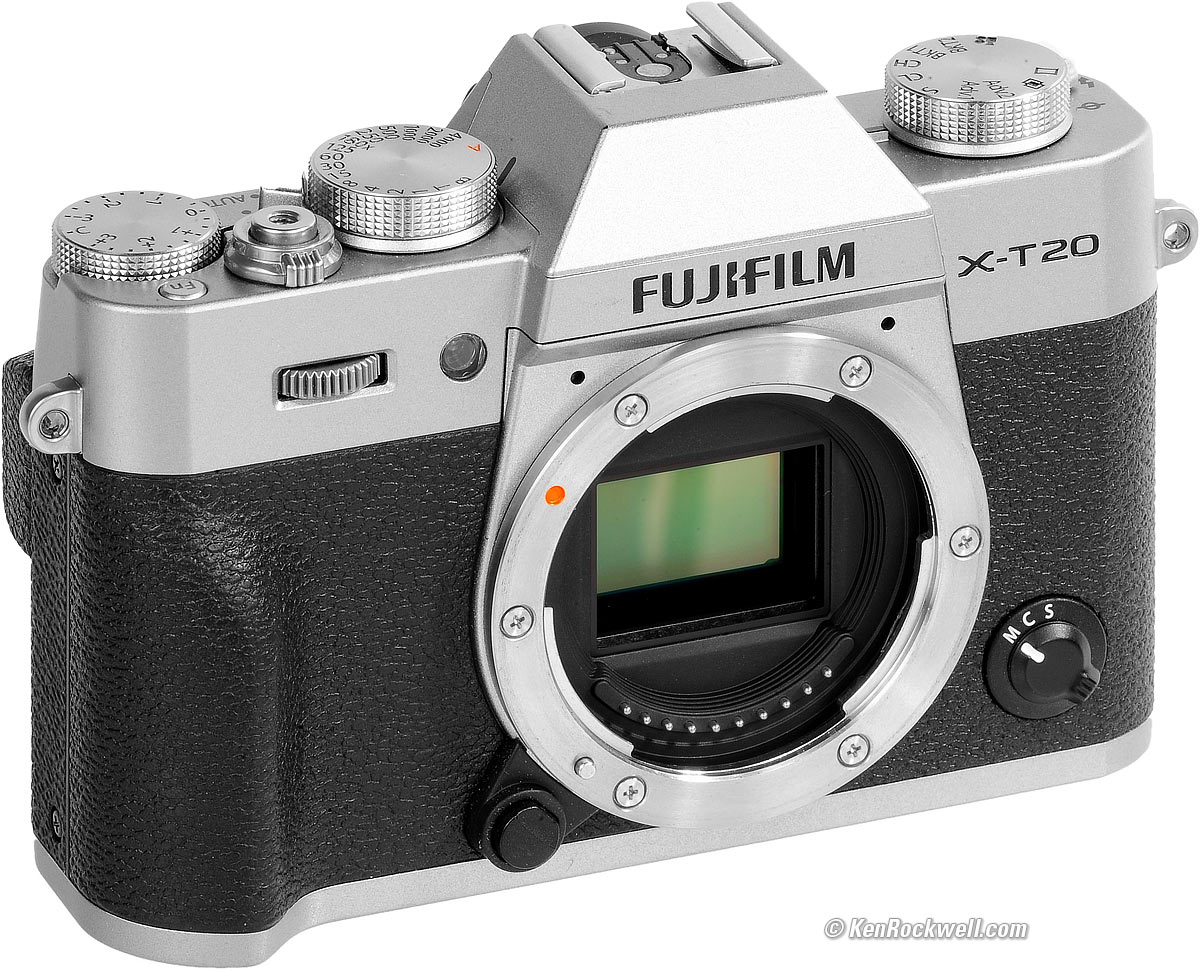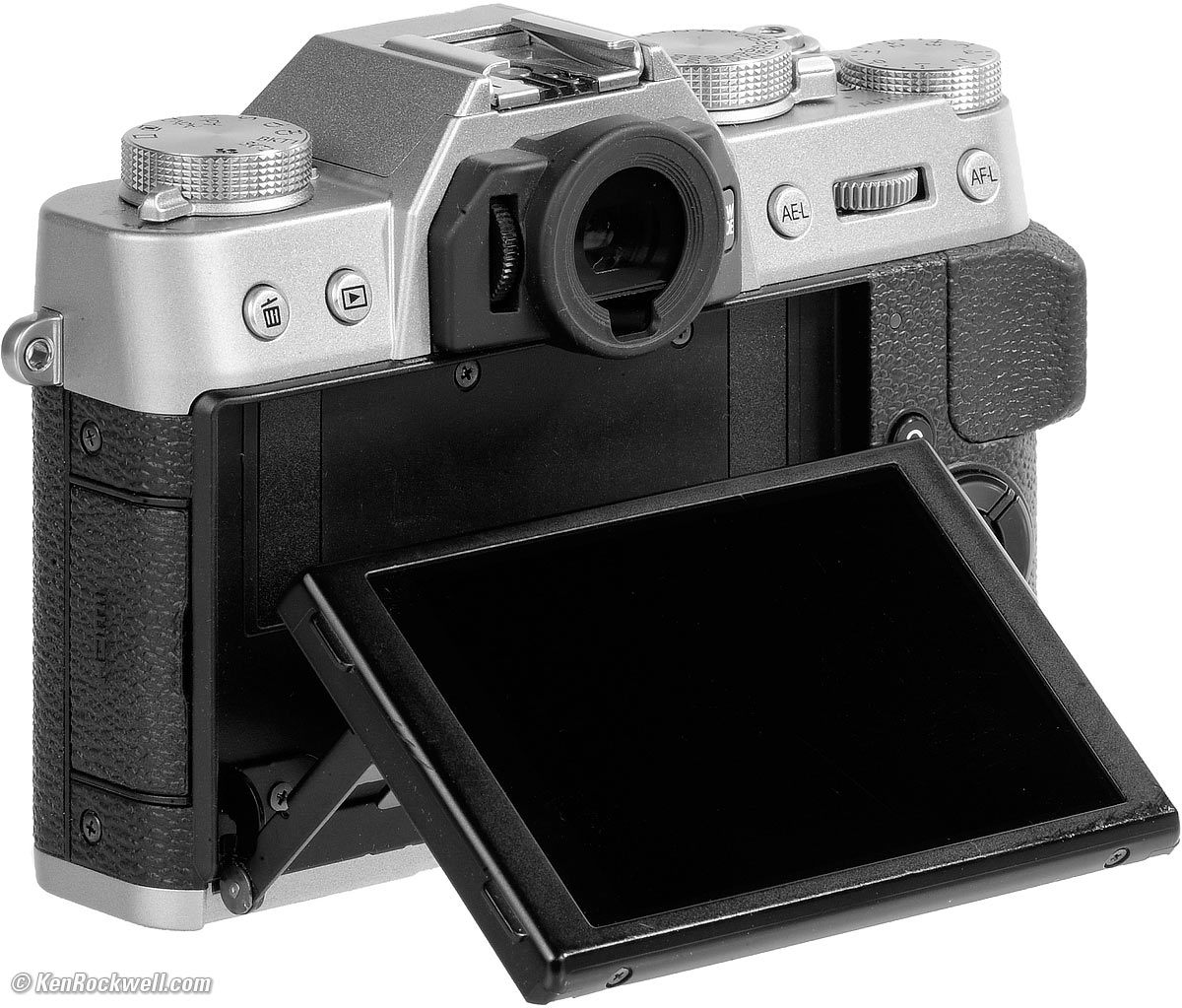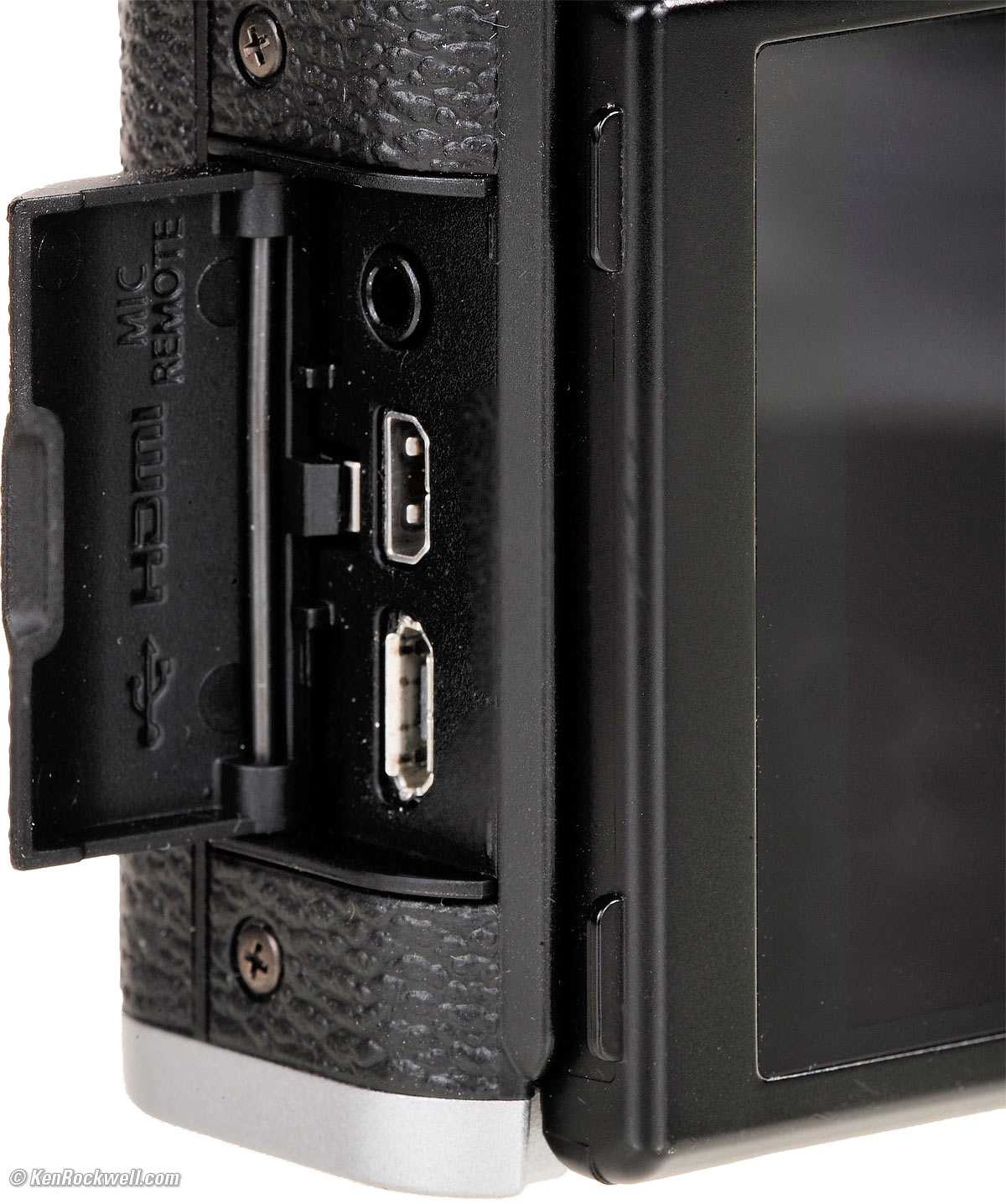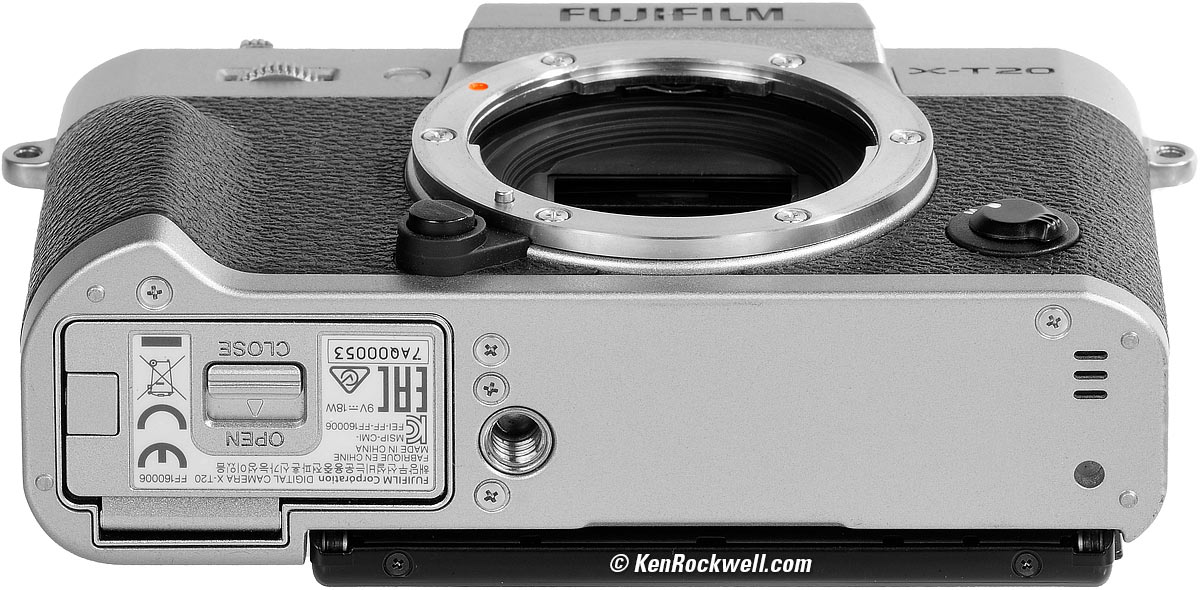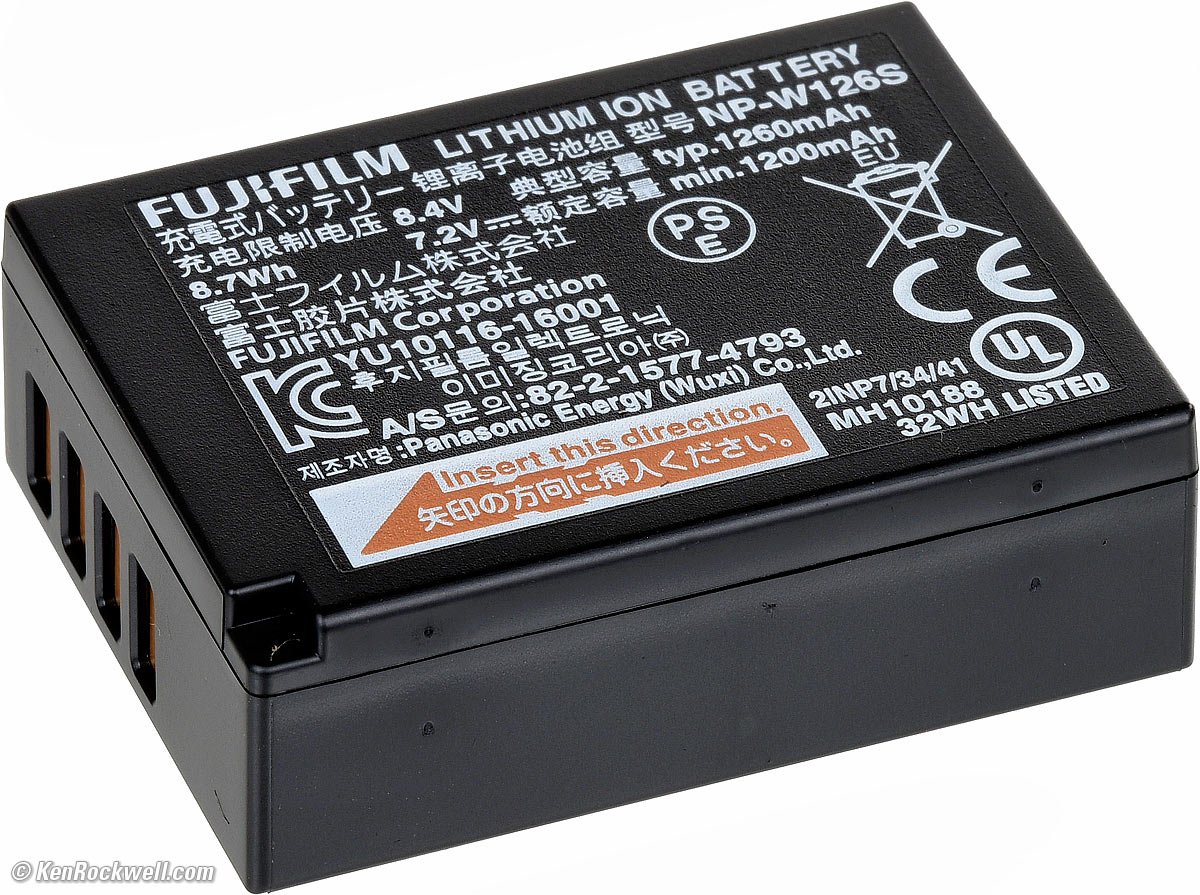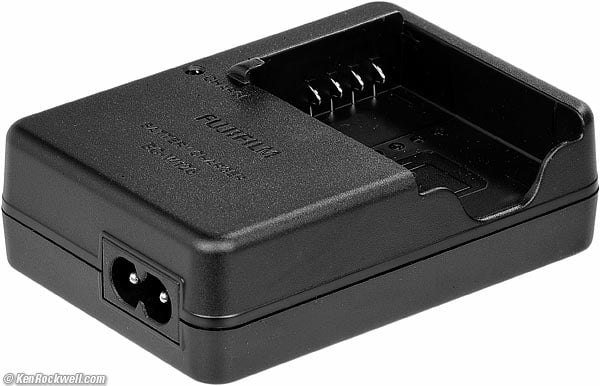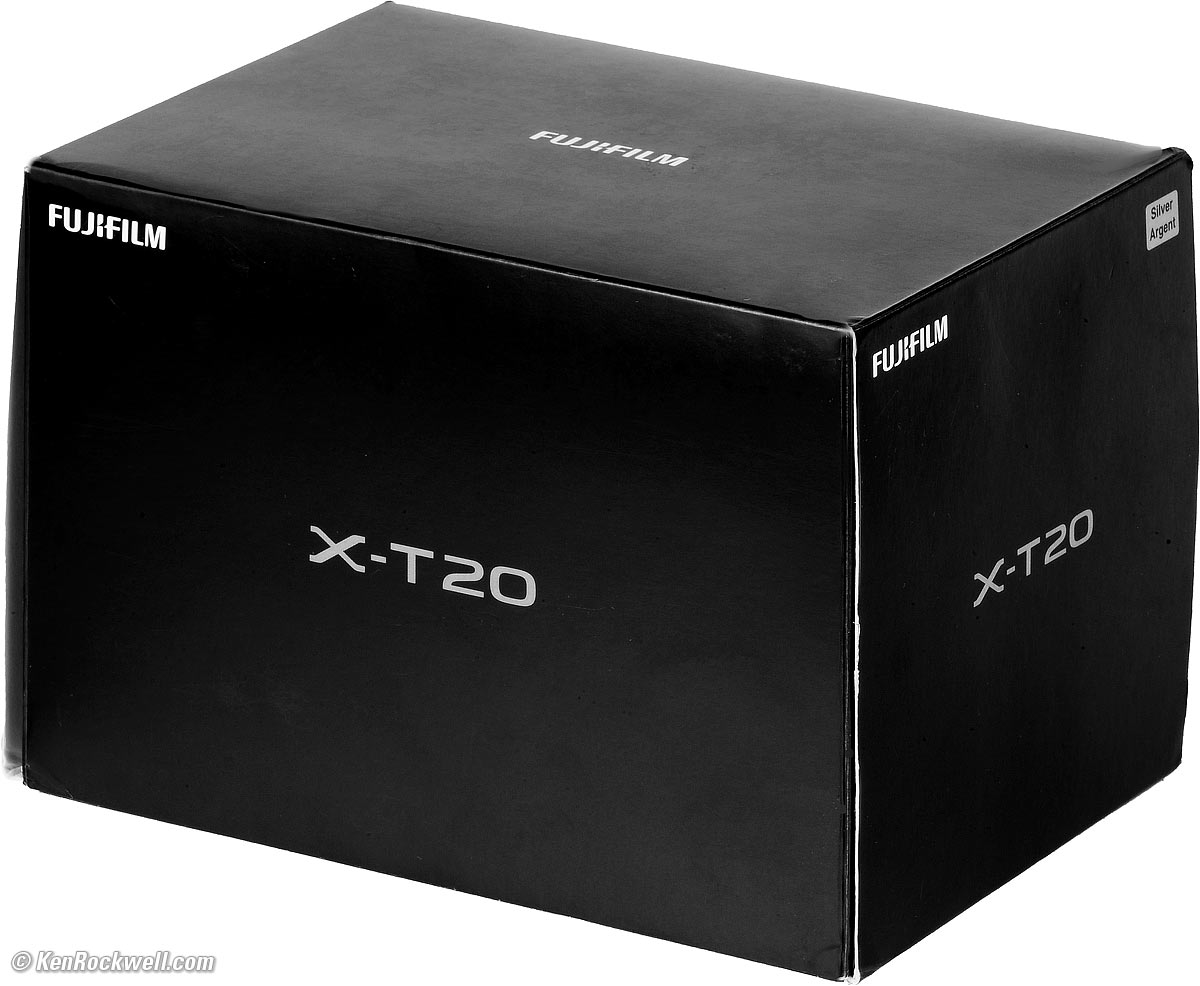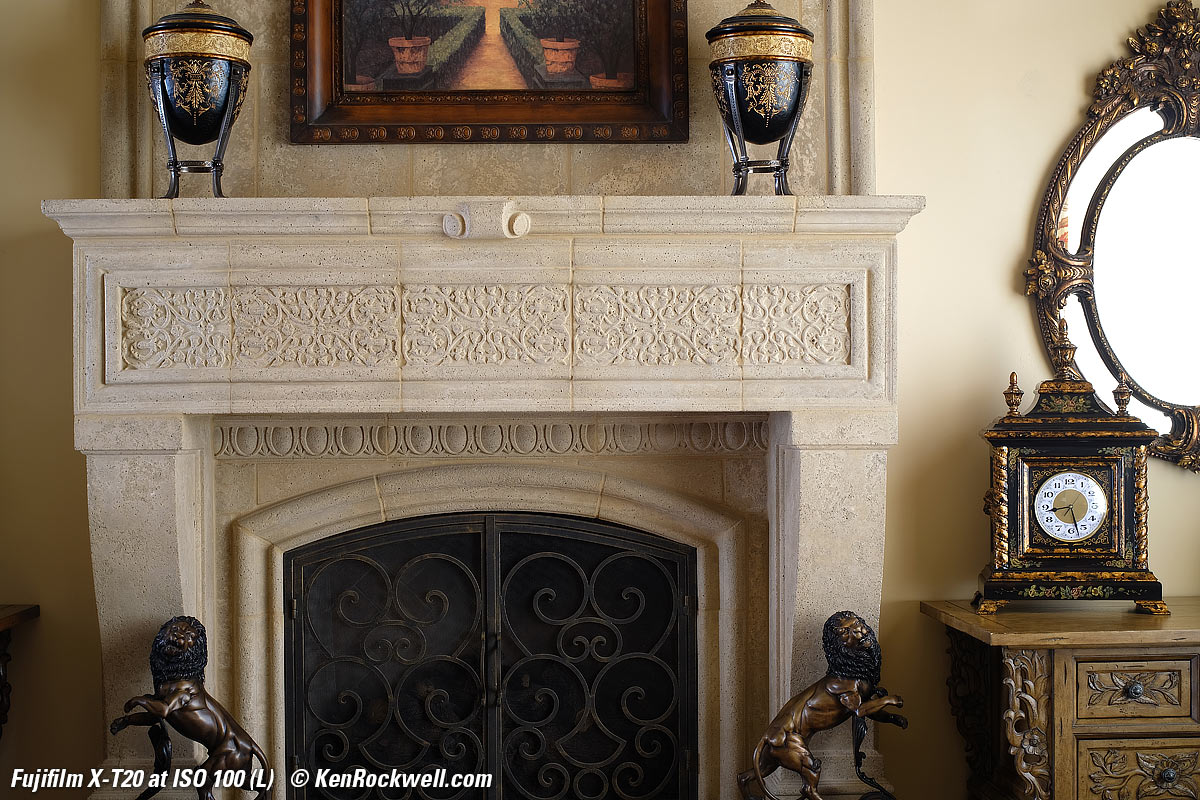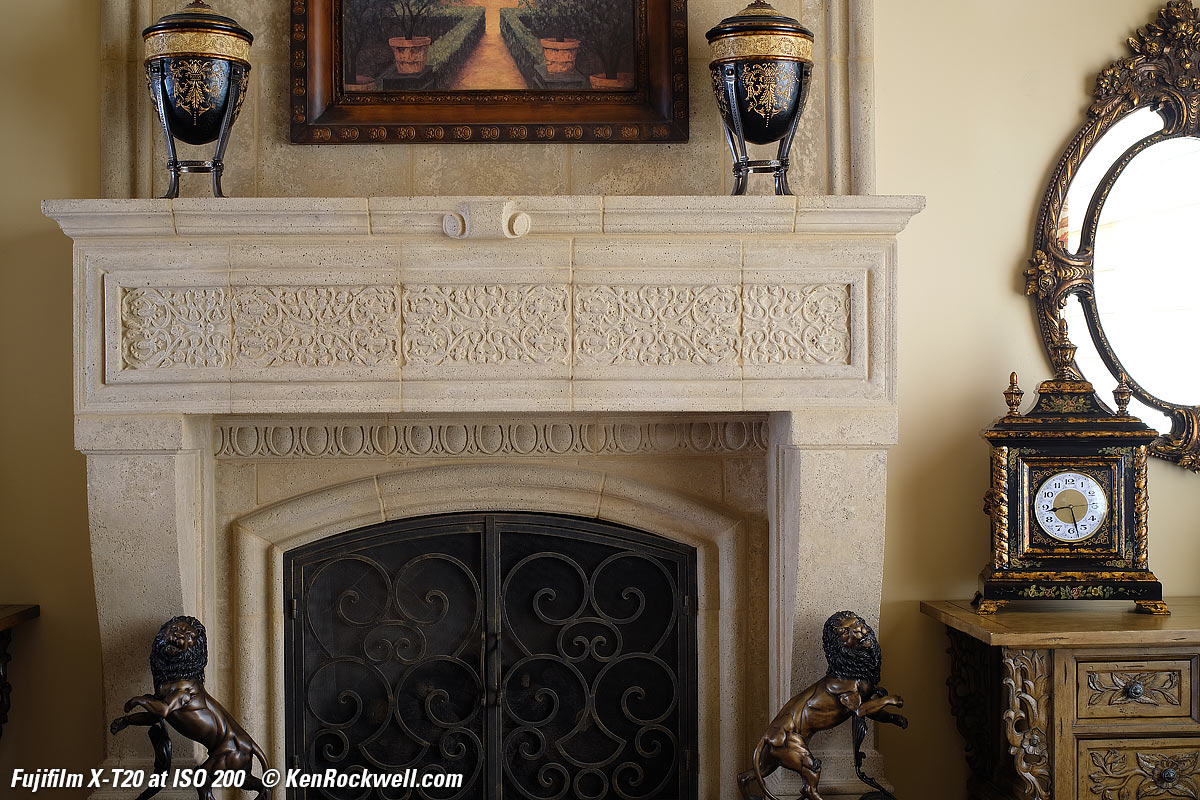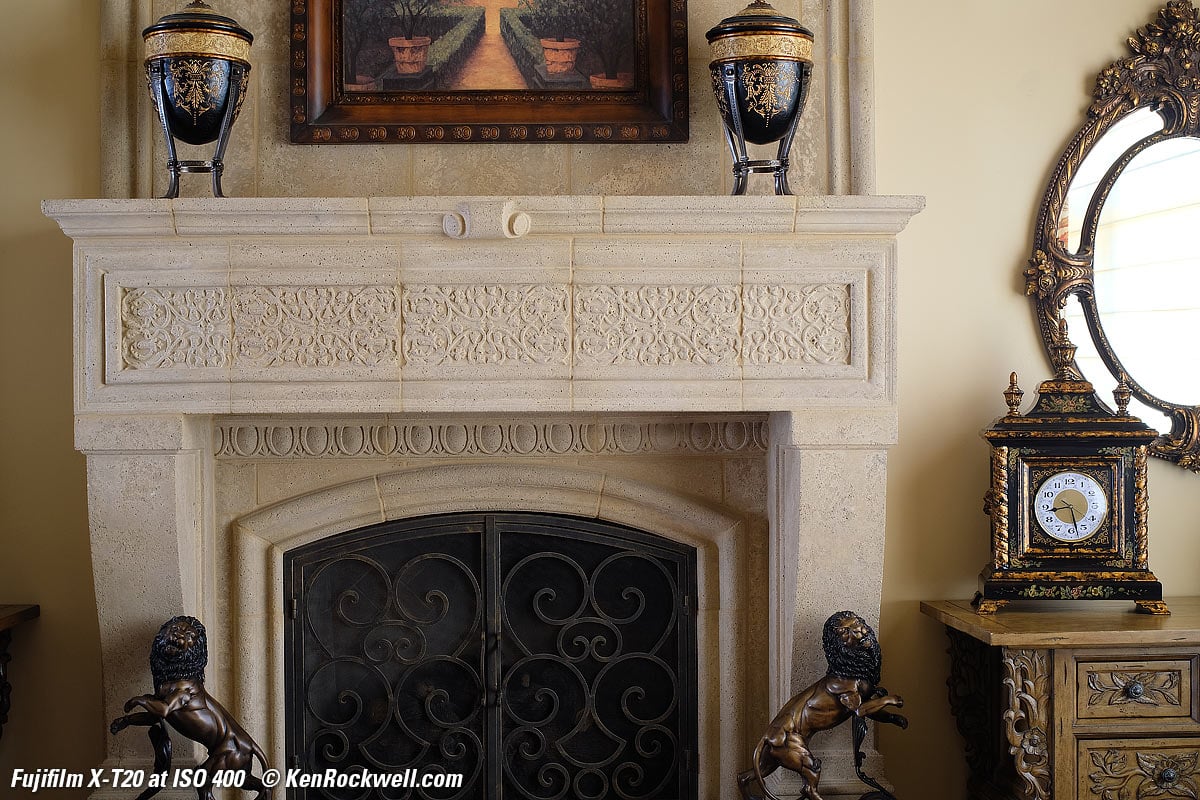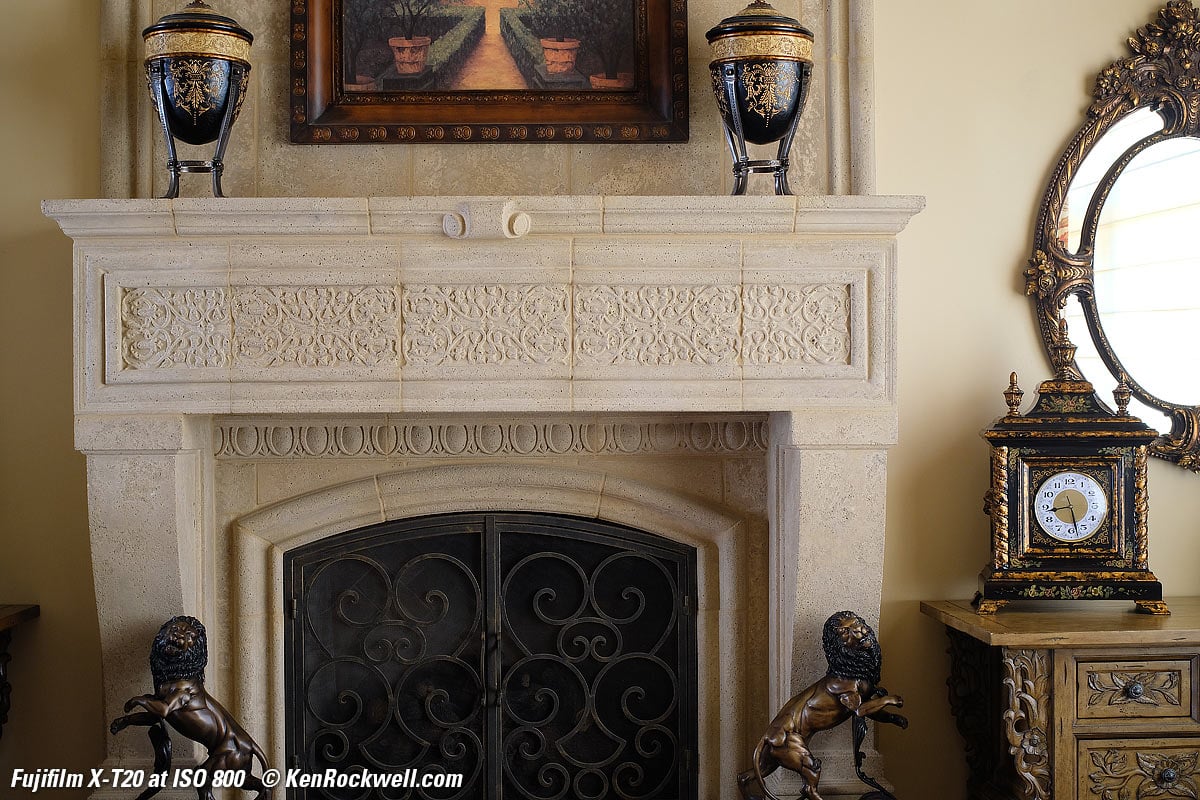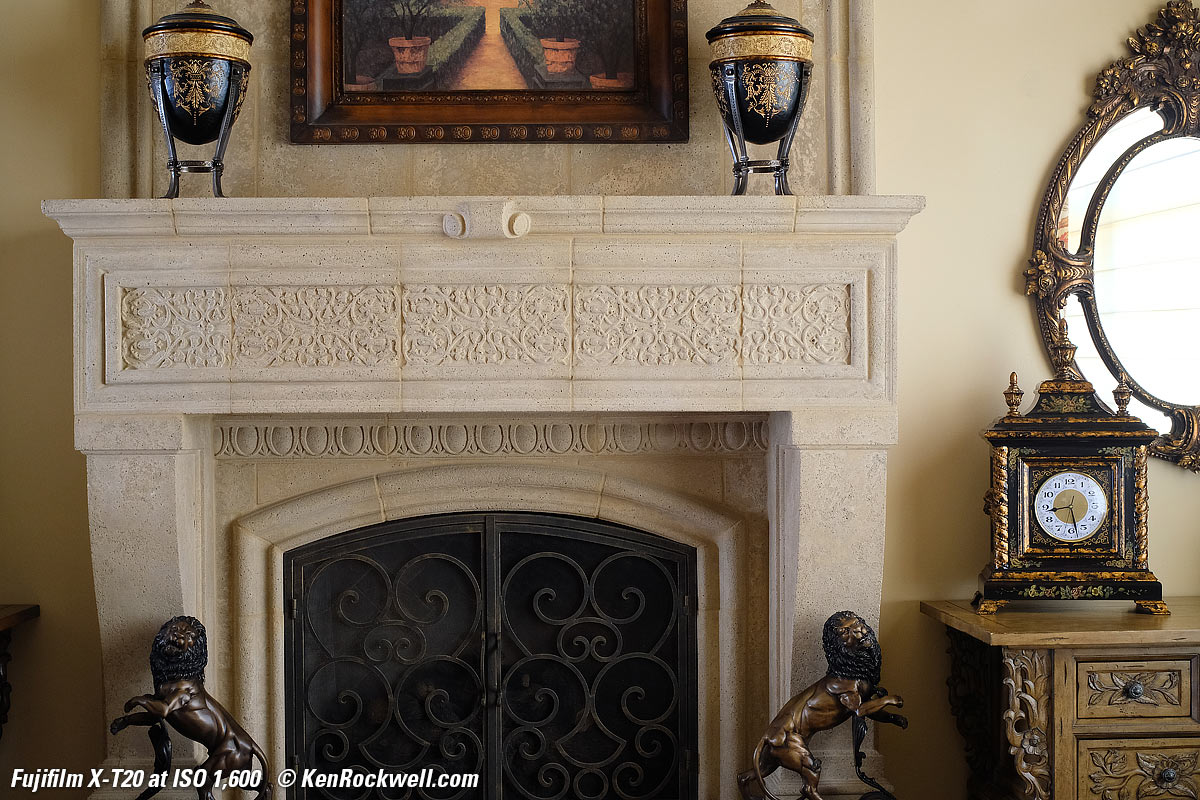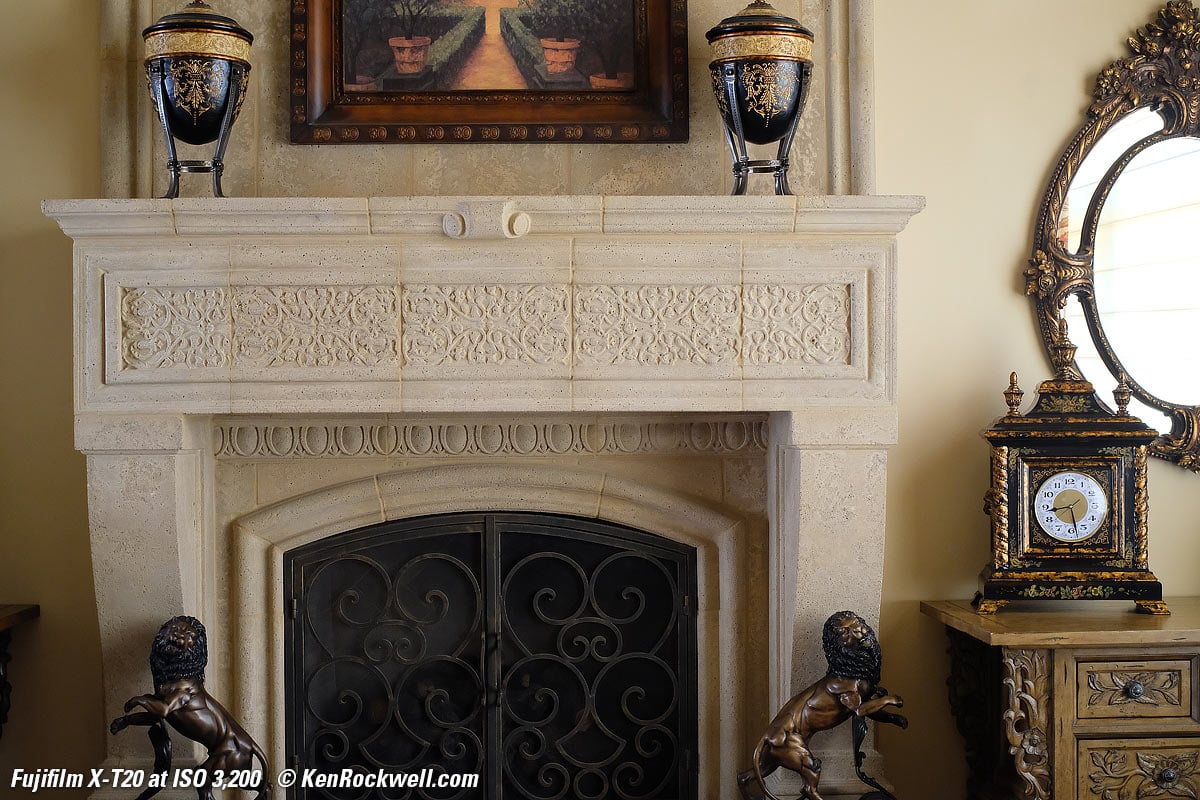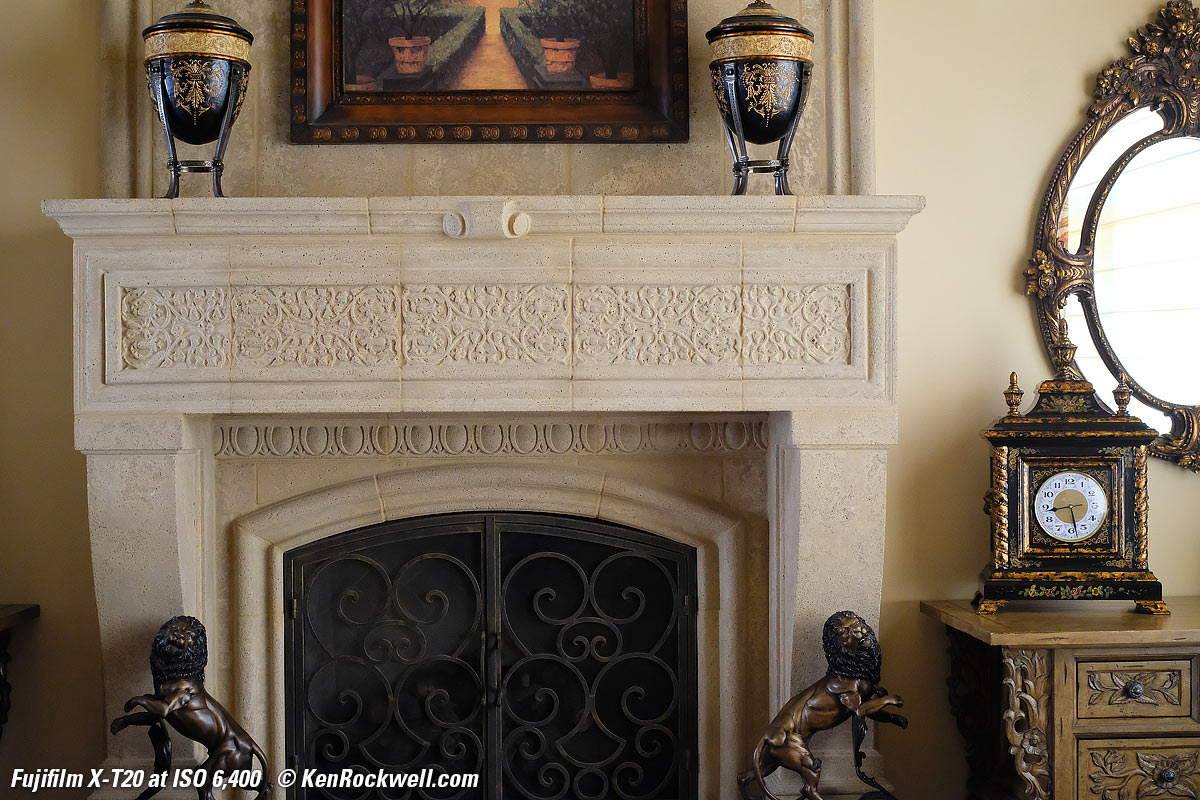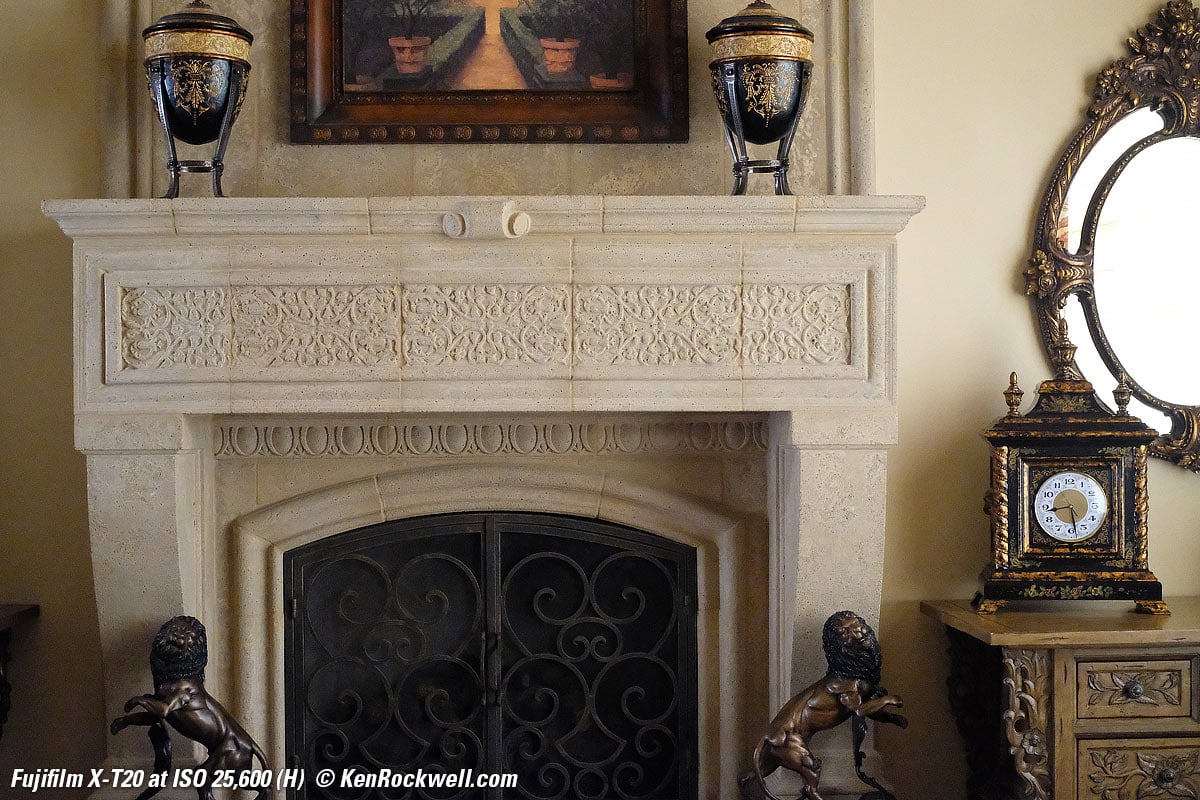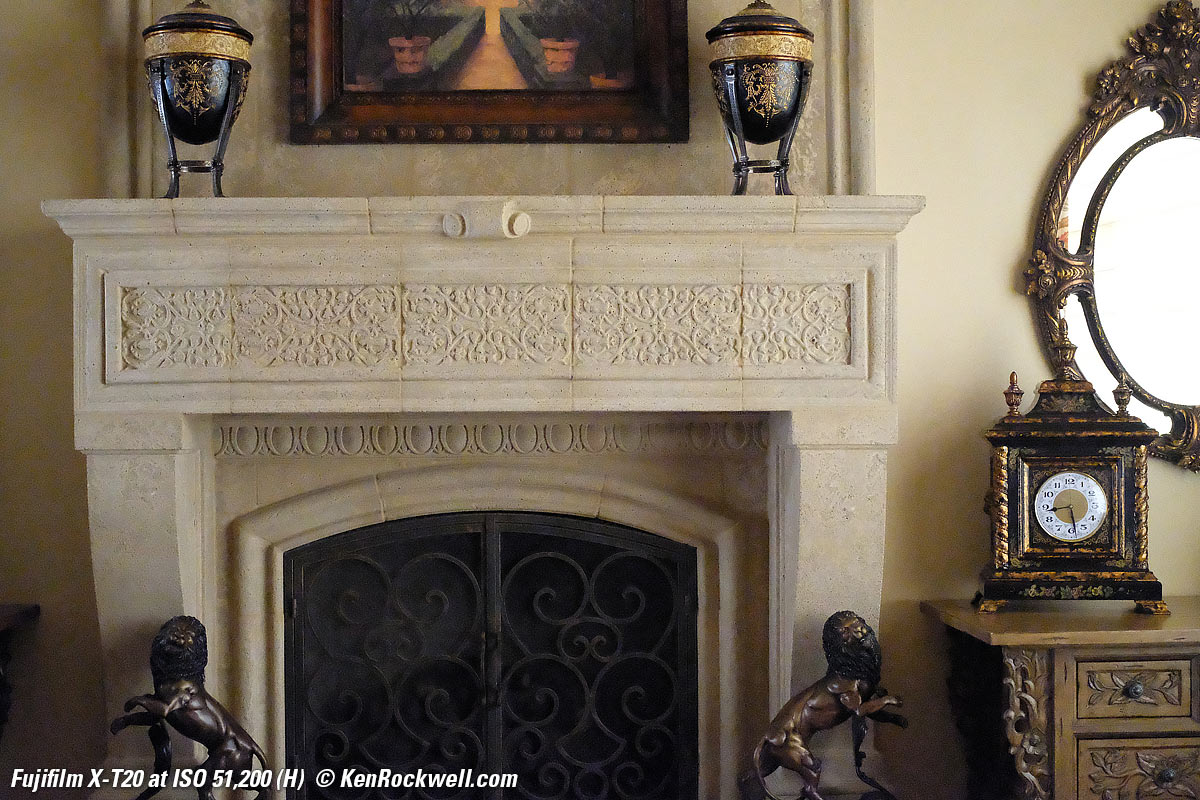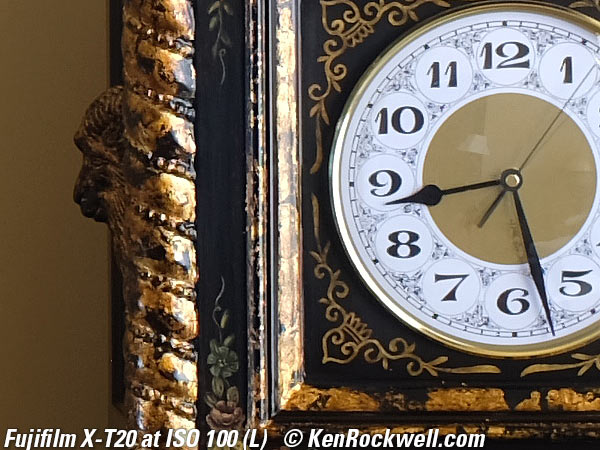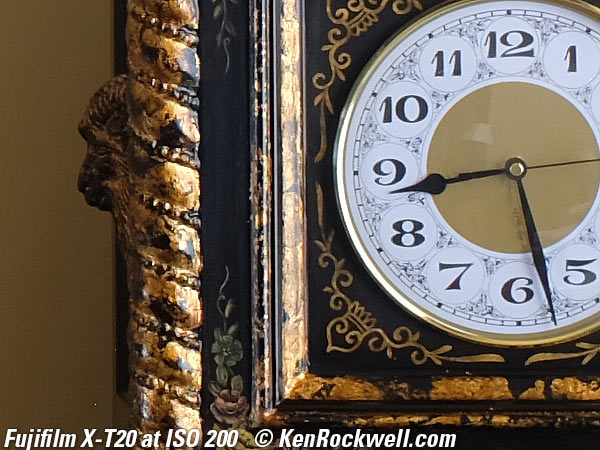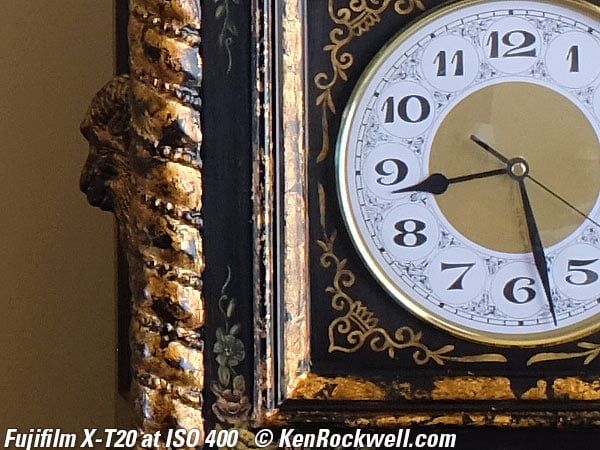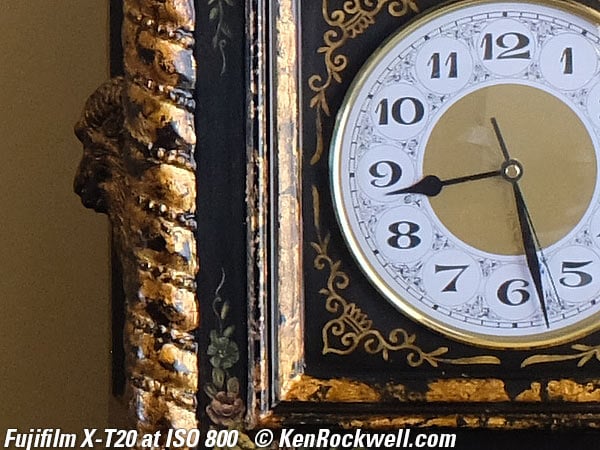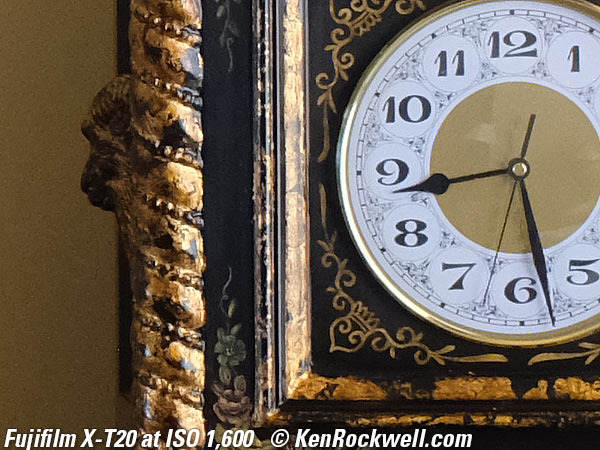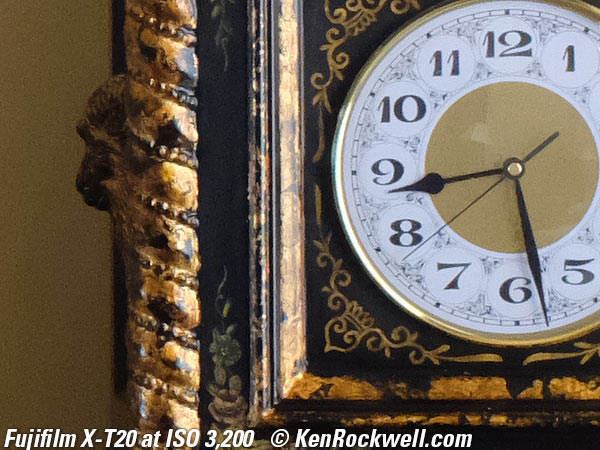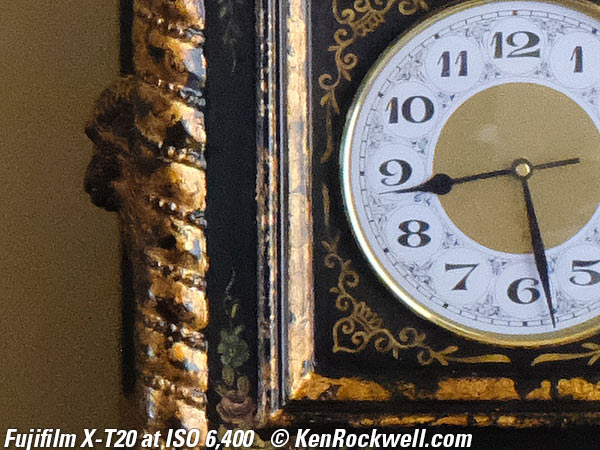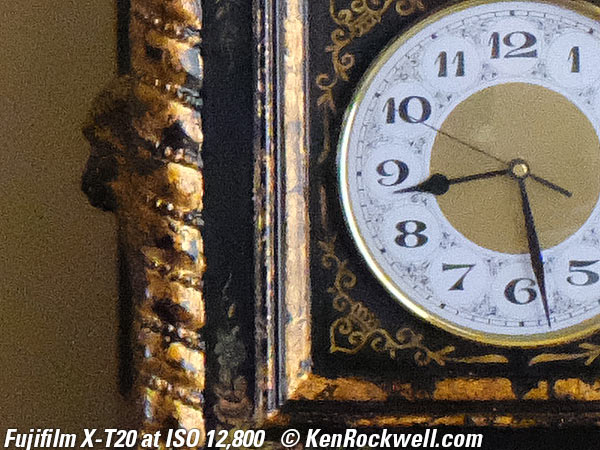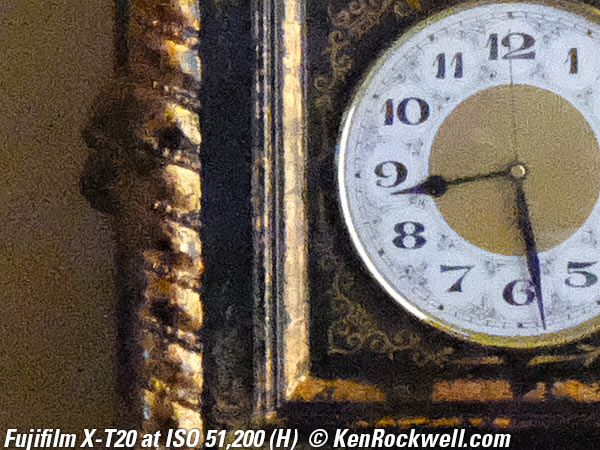Fujifilm X-T20
24 MP 14 FPS APS-C, 4K, ISO 51,200
Sample Images Intro Specifications
Performance Compared User's Guide
Fujifilm X-T20 (13.5 oz./382g with battery and card, $599 in silver or $599 in black or about $425 used if you know How to Win at eBay) and Fujifilm 16mm f/2.8. bigger. I'd get mine in many color and kit package variations at Adorama, at Amazon, at B&H, at Crutchfield in black or at Crutchfield in silver.
This all-content, junk-free website's biggest source of support is when you use those or any of these links when you get anything, regardless of the country in which you live. Thanks for helping me help you! Ken.
April 2019 Better Pictures Fuji Fuji Lenses Sony LEICA Zeiss Nikon Canon All Reviews
Fujifilm X-T20. bigger.
Fujifilm X-T20. bigger.
Sample Images
Top Sample Images Intro Specifications
Performance Compared User's Guide
(more at High ISOs)
These are all shot hand-held as NORMAL JPGs; no RAW files or FINE JPGs or tripods were used or needed.
Plant, 19 April 2019, 11:16 AM. Fujifilm X-T20, Fujifilm XF 16mm f/2.8, f/4.5 at 1/30 at Auto ISO 200, Perfectly Clear v3.6. bigger or camera-original © JPG file.
Hippies' Delight, 19 April 2019, 11:46 AM. Fujifilm X-T20, Fujifilm XF 16mm f/2.8, f/2.8 at 1/30 at Auto ISO 5,000, Perfectly Clear v3.6. bigger or full-resolution file.
Canary Palm, 19 April 2019, 9:13 AM. Fujifilm X-T20, built-in flash ON, Fujifilm XF 16mm f/2.8, f/8 at 1/170 at Auto ISO 400 at Auto Dynamic Range 200%, Perfectly Clear v3.6. bigger or full-resolution file or camera-original © file.
Sun and Clouds, 19 April 2019, 9:15 AM. Fujifilm X-T20, Fujifilm XF 16mm f/2.8, f/22 at 1/550 at Auto ISO 800 at Dynamic Range 400%, exactly as shot. bigger or camera-original © file.
Introduction
Top Sample Images Intro Specifications
Performance Compared User's Guide
|
I buy only from these approved sources. I can't vouch for ads below. |
The Fujifilm X-T20 is an adorable little camera that looks and feels like a baby 35mm SLR. It is dwarfed by a full size 35mm SLR like the Nikon FTn Photomic:
Fujifilm X-T20 w/16mm f/2.8 (24mm eq.) and Nikon FTn Photomic w/24mm f/2.8 F. bigger.
This X-T20 is 99% the same as the newer and more expensive X-T30. You'll have to strain to see anything different. The biggest difference between them is that this X-T20 has the usual 4-way rear controller, while the X-T30 only has a tiny thumb nubbin instead. I prefer this X-T20 as I prefer the larger rear controller!
Any of these, including the older X-T10, are my favorite of Fujifilm's interchangeable-lens cameras because they are tiny (smaller than the X-T3, X-Pro2 and X-H1), and have a built-in flash sorely lacking in many of Fujifilm's more expensive cameras. You can pay more and get less!
Like everything from Fujifilm, the X-T20's color rendition is highly optimized for people pictures with glowing skin tones, but too dull for vivid photos of nature, places and things. You can't beat this little camera for people photos with interchangeable lenses.
I'd get my X-T20 in many color and kit package variations at Adorama, at Amazon, at B&H, at Crutchfield in black or at Crutchfield in silver.
New
 24 MP sensor, up from 16MP in X-T10.
24 MP sensor, up from 16MP in X-T10.
 4K video.
4K video.
 NP-W126S battery allows in-camera USB charging.
NP-W126S battery allows in-camera USB charging.
Good
 Precise, mostly metal construction. Feels like a real camera, not a plastic toy.
Precise, mostly metal construction. Feels like a real camera, not a plastic toy.
 Lots of dedicated, clearly engraved dials.
Lots of dedicated, clearly engraved dials.
 Built-in flash.
Built-in flash.
 Live color RGB histograms displayed before you press the shutter (something neither Sony nor Nikon can do except on playback when it's too late), but you have to activate this in the menu system (see my User's Guide).
Live color RGB histograms displayed before you press the shutter (something neither Sony nor Nikon can do except on playback when it's too late), but you have to activate this in the menu system (see my User's Guide).
 Real hinged and spring-loaded connector door, not just a crappy plastic flap like Nikon, Sony and Canon use.
Real hinged and spring-loaded connector door, not just a crappy plastic flap like Nikon, Sony and Canon use.
 No need for a low-pass filter as usual with Fujifilm.
No need for a low-pass filter as usual with Fujifilm.
 Flipping touch LCD screen.
Flipping touch LCD screen.
 Standard threaded cable release socket.
Standard threaded cable release socket.
 Silent electronic shutter goes to 1/32,768.
Silent electronic shutter goes to 1/32,768.
 WiFi.
WiFi.
Bad
 Fujifilm's menu system has been awful and confusing for years with no signs of major improvement. They aren't paying attention here.
Fujifilm's menu system has been awful and confusing for years with no signs of major improvement. They aren't paying attention here.
 While Fujifilm's cameras have fast autofocus for single shots and have fast frame rates for subjects that hold still, none of Fujifilm's cameras can track motion or exposure well at the same time as running at a high frame rate. This is not a good camera for sports or action.
While Fujifilm's cameras have fast autofocus for single shots and have fast frame rates for subjects that hold still, none of Fujifilm's cameras can track motion or exposure well at the same time as running at a high frame rate. This is not a good camera for sports or action.
 Offshored to China; not made domestically in Japan.
Offshored to China; not made domestically in Japan.
Missing
 No built-in stabilization.
No built-in stabilization.
 No battery percentage readout, just a multi-segment icon.
No battery percentage readout, just a multi-segment icon.
 No automatic brightness control for the rear LCD.
No automatic brightness control for the rear LCD.
 Fully adjustable Auto ISO with three presets (good), except that one cannot shift the AUTO value for minimum shutter speed away from its default.
Fully adjustable Auto ISO with three presets (good), except that one cannot shift the AUTO value for minimum shutter speed away from its default.
 4K, 1,080 and 720 video, but no 480 or DCI video.
4K, 1,080 and 720 video, but no 480 or DCI video.
 No Bluetooth, GPS or NFC.
No Bluetooth, GPS or NFC.
 Very oddly it ignores down-clicks on playback to swap to different kinds of page views (picture only, picture with data, detailed data, etc.). Clicking the nubbin down is simply ignored and you have to click up multiple times just to go back to the previous kind of view. (selecting which picture by clicking left-right works normally.)
Very oddly it ignores down-clicks on playback to swap to different kinds of page views (picture only, picture with data, detailed data, etc.). Clicking the nubbin down is simply ignored and you have to click up multiple times just to go back to the previous kind of view. (selecting which picture by clicking left-right works normally.)
Specifications
Top Sample Images Intro Specifications
Performance Compared User's Guide
I'd get my X-T20 in many color and kit package variations at Adorama, at Amazon, at B&H, at Crutchfield in black or at Crutchfield in silver.
Lens Compatibility
Fujifilm X-T20. bigger.
Uses Fujifilm's Fujinon X-Mount lenses.
Image Sensor
Fujifilm X-T20. bigger.
24 MP.
15.6 × 23.5 mm CMOS.
3:2 aspect ratio.
1.5× crop factor.
Ultrasonic cleaner.
ISO
Regular: ISO 200 ~ 12,800.
Pushed and pulled: ISO 100 ~ 51,200.
Auto ISO
Fully adjustable, except that one cannot shift the AUTO value for minimum shutter speed away from its default.
Dynamic Ranges
100% (from ISO 200), 200% (from ISO 400), 400% (from ISO 800) or AUTO (100% or 200%).
Still Image Sizes
Large: 6,000 × 4,000 pixels native (24.00 MP).
Medium: 4,240 × 2,832 (12.0 MP).
Small: 3,008 × 2,000 (6.0 MP).
Swept Stitched Panoramas
Large: 9,600 × 1,440 (vertical: 2,160 × 9,600).
Medium: 6,400 × 1,440 (vertical: 2,160 × 6,400).
(no Small setting).
Cropped Aspect Ratios
1:1 Square
L: 4,000 × 4,000.
M: 2,832 × 2,832.
S: 2,000 × 2,000.
16:9
L: 6,000 × 3,376.
M: 4,240 × 2,384.
S: 3,008 × 1,688.
Still Formats
JPG and/or raw.
sRGB and Adobe RGB.
Electronic Finder
0.39" OLED.
2,360,000 dots.
0.62× magnification w/33mm lens (50mm equivalent).
30 diagonal (25º horizontal) apparent angle.
17.5mm eye relief.
-4 ~ +2 diopters.
Autofocus
Up to 325 selectable points.
Light Meter
256 zones, multi, spot, average or center weighted.
Shutters
Mechanical Shutter
1/4,000 to 4 seconds (P mode), to 30 seconds (A, S or M modes).
To one hour in Bulb mode.
Flash sync speed: 1/180.
Silent Electronic Shutter
1/4,000 to 4 seconds (P mode).
1/32,768 to 1 second (P, A, S, M or TIME modes)
1 second in Bulb mode.
Remote Releases
Standard threaded cable release.
Free FUJIFILM Camera Remote app.
Fujifilm Remote Release RR-90 that plugs into the USB socket.
2.5mm Ø remote cords.
Flash
1/180 sync speed.
Built-in Flash
Yes, pops up.
GN 5m/16 feet at ISO 100.
External Flash
Dedicated hot shoe.
No Prontor-Compur (PC) terminal; use the built-in flash to trigger your slaves or just use a hot-shoe adapter for corded sync.
Still Frame Rates & Buffer (Burst) Sizes
Mechanical Shutter
8 FPS: JPG: 62 frames, Lossless compression RAW: 25 frames, Uncompressed RAW: 23 frames.
5 FPS: JPG: 68 frames, Lossless compression RAW: 28 frames Uncompressed RAW: 25 frames.
4 FPS: JPG: 73 frames, Lossless compression RAW: 29 frames Uncompressed RAW: 25 frames.
3 FPS: JPG: 81 frames, Lossless compression RAW: 32 frames Uncompressed RAW: 27 frames.
Electronic Shutter
14 FPS: JPG: 43 frames, Lossless compression RAW: 23 frames, Uncompressed RAW: 22 frames.
11 FPS: JPG: 56 frames, Lossless compression RAW: 24 frames, Uncompressed RAW: 23 frames.
Video
File Format
.MOV holding MPEG-4 AVC/H.264 video and 24 bits at 48 ksps PCM stereo audio.
Video Frame Sizes and Rates
4K (3,840 × 2,160): 29.97p/25p/24p/23.976p 100Mbps up to 10 minute take length.
1,920 × 1,080: 59.94p/50p/29.97p/25p/24p/23.976p at 36Mbps up to 15 minute take length.
1,280 × 720: 59.94p/50p/29.97p/25p/24p/23.976p at 18Mbps up to 30 minute take length.
4GB maximum file size; keeps writing sequential 4GB files for you to stitch together later.
Audio
Recorded only along with video.
Stereo microphones built in.
Mic-in jack with plug-in power overrides built-in mic.
LCD Monitor
Fujifilm X-T20. bigger.
3" (76mm) diagonal touch screen.
1,040,000 dots.
3:2 aspect ratio.
Swivels up 90º and down 45º, but not left or right.
No anti-smudge coating.
No anti-reflection coating.
Connectors
Fujifilm X-T20. bigger.
2.5mm Mic input. 2.5mm remotes also plug in here.
HDMI micro D.
Micro-B USB 2.0. (The Fujifilm Remote Release RR-90 also plugs in here).
WiFi
IEEE802.11b/g/n infrastructure.
WEP / WPA / WPA2 mixed mode.
2.412 ~ 2.462 GHz (11 channels) in USA, Canada and Taiwan.
2.412 ~ 2.472 GHz (13 channels), rest of world.
Storage
One slot.
Takes an SD (up to 2GB), SDHC (up to 32GB) or SDXC (up to 256GB) card.
Quality
Fujifilm X-T20. bigger.
Made in China.
Power & Battery
Rated 350 shots per charge or about 60 minutes of video shooting using the finder or rear LCD.
In BOOST PERFORMANCE Mode it's rated 260 shots with the finder or rear LCD.
New NP-W126S Li-Ion battery. Same as used in the X-T30, X-H1, X-T3, X-100F and X-T2; it's a newer version of the NP-W126 used in the X-Pro1 and X-E1.
7.2V, 1,260 mAh.
1.4 × 1.9 × 0.6 inches.
36.4 × 47.1 × 15.7 millimeters.
Rated 1.7 oz. (47g).
Charging
It charges via micro USB with any random 99¢ cable and any regular 5V USB source.
The X-T20 also includes an external charger:
Included Fuji BC-W126 Charger, also included with X100F, X-Pro1 and X-T1.
Corded, uses common "∞" shaped plug end.
100~240V, 50-60 Hz.
Made in China by JET.
Rated 13~21 VA input, 8.4VDC 0.6A output.
Rated 150 minute (2.5 hour) charge time.
5º ~ 40º C (41º ~ 104º F) operating.
65 mm × 91.5 mm × 28 mm.
2.6 in. × 3.6 in. × 1.1 in.
2.7 oz. (77g).
Size
4.66 × 3.26 × 1.63 inches HWD.
118.4 × 82.8 × 41.4 millimeters HWD.
Weight
13.485 oz. (382.3 g) with battery and card, actual measured weight.
Rated 13.5 oz. (383 g) with battery and card, 11.8 oz. (333 g) stripped.
Environment
Operating
0º ~ 40 º C (32 ~ 104º F).
10 to 80 % RH, non-condensing.
Included
X-T20 body, body cap and strap.
NP-W126S rechargeable Li-ion battery.
BC-W126 Charger.
2 metal strap clips (AKA split rings).
2 protective covers to prevent the rings from marring the body.
Clip attaching tool.
Printed owner's manual.
Announced
19 January 2017.
Fuji's Internal Product Number
FF160006, X-T20 chassis.
16542359 silver body.
16542490 black body.
Packaging
Box, Fujifilm X-T20. bigger.
Microcorrugated cardboard box with formed pulp innards.
Price, USA
April 2019
$599 in silver, $599 in black or about $425 used if you know How to Win at eBay.
Performance
Top Sample Images Intro Specifications
Performance Compared User's Guide
Overall Autofocus Color Rendition
Electronic Finder Ergonomics Exposure
High ISOs Auto ISO Auto White Balance
Lens Corrections Mechanics Rear LCD
I'd get my X-T20 in many color and kit package variations at Adorama, at Amazon, at B&H, at Crutchfield in black or at Crutchfield in silver.
Overall
The Fujifilm X-T20 is a brilliant little camera that makes great people pictures in any kind of light.
It's the best of Fujifilm's cameras because it's inexpensive, includes a built-in flash and an exposure compensation dial sadly lacking on some of Fujifilm's more expensive cameras.
Autofocus
The X-T20 has fast frame rates for subjects that hold still and fast autofocus for single shots.
Autofocus is great for the people photos for which Fujifilm cameras are optimized. It automatically finds eyes and faces even in crowds and just focuses. It's much, much better than Nikon's much more expensive Z series. Bravo!
If nothing is moving, autofocus is fast.
Be sure to turn on face recognition, which is off by default (see my User's Guide).
Autofocus of all of Fujifilm's cameras is painfully slow while running in continuous shutter mode. The sensor isn't very good at shooting and autofocusing at the same time, making all the Fujifilm cameras poor choices for sports or action.
It's nice that the touchscreen can be set to be a big trackpad for moving around the AF area as you look through the finder, but sadly it doesn't respond as immediately as I'd like.
Color Rendition
Color rendition is the same as other Fujifilm cameras. This means that in-camera JPGs tend towards muted colors and low contrast ideal for people pictures. Even set to COLOR +4 the colors are subdued.
I'm not a fan of the film emulation and special picture modes; except for people pictures for which this camera excels I'm not happy with it for my style for nature, landscape, architecture and other genres as its JPGs are too subtle for me.
If you shoot raw then color rendition depends on your choice of software. I don't bother with raw.
Electronic Viewfinder
The finder is very good, sharp and bright, with pretty good automatic brightness control.
It's certainly smaller than the huge X-H1 finder, and more than sufficient as a sharp, legible finder.
Like most cameras its biggest limitation is its variable-dioptometric optics, which can make it softer than it could be as these eyepiece optics are far from perfect. You'll see the usual swimmy astigmatism due to the imperfect eyepiece; you never really can adjust it to be perfectly sharp all over as you can do so spectacularly in the X-H1.
The X-T20's finder sets brightness based on what light is coming through the lens, so for instance if you point the camera down at a shadow while you're playing back outside, the finder gets too dark. You have to be conscious of where you're pointing it to optimize the finder brightness.
Ergonomics
Good
This jewel of a little camera is loaded with clearly engraved dials for many functions like advance mode, shutter speed and exposure compensation. It also has a switch for AF mode and levers for other single functions, making these items much easier to set than on other brands of camera which more often force these settings into unnamed dials and function buttons.
The X-T20 has a nice little spring-loaded connector door that flips open or closes easily that's a huge advantage over the crappy plastic flaps that fall off of Nikon, Sony and Canon's mirrorless cameras.
It's easier to use the X-T20's ISO button than it is to use the defective ISO dials on other Fujifilm cameras. Sadly Fujifilm's ISO dials skip a couple of values, and demand you go back into much more complex menus to program which values you want to assign to the H and L settings of those dial — while it's easy to set any ISO value with the X-T20's button (You can assign which button is ISO at MENU > WRENCH > BUTTON/DIAL SETTING > Fn/AE-L/AF-L BUTTON SETTING > (your choice of Fn button) > ISO.
Bad
The PLAY and TRASH buttons are on the wrong (left) side, so they take a second hand to use them. You can assign another button on the right to be a play button if you like (MENU > WRENCH > BUTTON/DIAL SETTING > Fn/AE-L/AF-L BUTTON SETTING > (your choice of Fn button) > PLAY) and then press that Fn button to play.
The card and battery door lacks a spring catch, so you have to remember to lock the catch manually any time you want the door to stay closed.
There is a slight delay between moving the aperture ring and the updated value being displayed in the finder. While it seems negotiable as you play with the camera at your desk, it's quite a drag while you're out shooting and need the data to update instantly as you're making settings. You have to wait a slight moment every time you change the setting to read what you set, and a "slight moment" is too long when you're trying to shoot.
The card is right by the door hinge so it's difficult to grab. I usually press it in and let it shoot across the room to get it out.
The menu system is atrocious (very bad!). All Fuji cameras take longer than they should to find and set menu items, and even if you find the right item, you might not recognize it.
For instance, Card Format is buried at MENU > Wrench > User Setting > Format, and it took me years on other Fujifilm cameras to discover that to get live color RGB histograms before you take a picture you have to do it by assigning one of the custom keys to Histogram and then press it — and no one at Fujifilm knew that (see my User's Guide). If you have the camera set in one of many ways in which flash won't fire (like Silent Shutter), the flash option simply disappears and makes you have to guess what to do to get flash going — and this goes on and on. Geesh!
The menu system always opens at the top item, not where you last left off.
Once you get your menus and camera set as you want it it shoots fast due to all the dials, but unless you use your camera often you'll forget where to find things. To find just about anything I usually have to go through the entire menu system to find it. Want to set the Touch Screen? It's hidden inside MENU > Button/Dial Setting > Page 2 > Touchscreen setting. Good luck!
This is a frustrating camera to set up unless you're both patient and talented. Most users will never figure out how to use most of the glitzier features, and Heaven help you if you only use it once a month.
Exposure
Like most mirrorless cameras, exposure is almost always perfect.
High ISO Performance
High ISO performance is superb.
Images are quite usable even at the insanely high ISO of 51,200!
Complete Images
When printed or displayed at reasonable size as I'm showing below, images from the X-T20 look the same at any ISO from ISO 100 (L) up to ISO 51,200 (H). Therefore use whatever ISO you need if you need it to get a sharp photo.
Click any for the camera-original © file:
Click any for the camera-original © file.
600 × 450 Pixel Crops From Above
The real differences between the various ISOs is most visible when enlarged greatly as I show below.
If these 600 × 450 pixel crops are about 3" (7.5cm) wide on your screen, then the complete image printed at this same high magnification would be about 21 × 31" (1.7 × 2.6 feet or 50 × 80 cm).
If these 600 × 450 pixel crops are about 6" (15cm) wide on your screen, then the complete image printed at this same extreme magnification would be about 42 × 62" (3.5 × 5.2 feet or 1.05 × 1.6 meters).
If these 600 × 450 pixel crops are about 12" (30cm) wide on your screen, then the complete image printed at this same insane magnification would be about 83 × 125" (6.9 × 10.4 feet or 2.1 × 3.2 meters).
As you'll see, they are sharpest at ISO 100 and become progressively softer at higher ISOs. All digital cameras do this due to their noise reduction; this is normal.
The images seem just about unchanged up to ISO 800, which is excellent, and get a little softer starting at ISO 3,200, above this they get softer and softer.
ISO 12,800 gets just a little noisier, and ISO 25,600 and 51,200 are noisier and lose more fine details, but still quite usable unless you're actually going to print on paper 35 feet wide.
Click any for the camera-original © file:
Click any for the camera-original © file.
If these 600 × 450 pixel crops are about 3" (7.5cm) wide on your screen, then the complete image printed at this same high magnification would be about 21 × 31" (1.7 × 2.6 feet or 50 × 80 cm).
If these 600 × 450 pixel crops are about 6" (15cm) wide on your screen, then the complete image printed at this same extreme magnification would be about 42 × 62" (3.5 × 5.2 feet or 1.05 × 1.6 meters).
If these 600 × 450 pixel crops are about 12" (30cm) wide on your screen, then the complete image printed at this same insane magnification would be about 83 × 125" (6.9 × 10.4 feet or 2.1 × 3.2 meters).
Auto ISO
Auto ISO works well and is very flexible, with high and low ISO limits programmable, as well as minimum shutter speed.
Base (default or minimum ISO) is set from ISO 200 to 12,800 in third stops.
Max ISO is set in full stops from ISO 400 to ISO 12,800.
Minimum shutter speed is set in full stops from 1/4 to 1/30 and in third stops from 1/30 to 1/500.
There is an AUTO setting for minimum shutter speed, but sadly you can't shift this value from its default of about 1/focal length.
Auto White Balance
Auto White Balance is great, even shot in nasty mixed light it always seems to do the best job possible.
It's helped by Fujifilm's low contrast images which tend to downplay any color nastiness.
Lens Corrections
Lens corrections are all put in a "LENS MODULATION OPTIMIZER" option set at MENU > I.Q. > LENS MODULATION OPTIMIZER.
I see no separate options for falloff, distortion, diffraction etc.; they're either all ON or all OFF.
Mechanical Quality
The X-T20 is made better than most mirrorless cameras, with lots of metal:
Metal
Strap lugs, top left cover, advance mode dial, shutter speed dial, power switch, shutter release button, exposure compensation dial, right top cover, front and rear unmarked control dials, lens mount, LCD panel flip linkage, camera bottom cover and tripod socket.
Plastic
Flash pop-up lever, buttons, top center cover (which is the pop-up flash), LCD frame and cover, front focus mode lever and battery door.
Rubber
Textured grip covers.
Markings
About 60% engraved and filled with paint, and about 40% just printed.
Identity
Engraved and filled with paint on front of top cover.
Printed on sticker on bottom.
Serial Number
Printed on a sticker glued on the bottom.
Made in
China.
Rear LCD Monitor
The rear LCD has no automatic brightness control, so it's dim in daylight unless you turn it up manually.
It swivels up and down, but can't twist 180º for self-portraits.
Playback
While images swap from one to another instantly, they first display as a slightly fuzzy preview for a half a second before popping-in sharp a moment later.
Very oddly one can click up to change to a different kind of page view (picture only, picture with data, detailed data, etc.), but clicking down is simply ignored.
"Autorotate Playback" (MENU > WRENCH > SCREEN SET-UP (page 2/2) > AUTOROTATE PB) isn't; it just rotates vertical shots that then take up only half of the screen. The X-T20 isn't as smart as an iPhone and won't rotate playback images as you rotate the camera during playback.
Data
Sadly cards are not properly titled. They are titled as "Untitled,” making them easy to confuse in your computer's finder when trying to figure out what is what. They should be titled "FUJIXT20," but they aren't.
The good news is that there's only a DCIM folder on the card, not all the other garbage folders some makers like Sony throw on there.
Power & Battery
There is no spring-loading on the battery door catch. You have to pay attention and carefully slide it to lock it each time, otherwise it flops open.
It's easy to charge with any generic micro USB cable (I get mine at the 99¢ store) from any regular 5V USB socket.
It draws 482mA while charging over USB from 5V with a cheap cable. It continues to draw 35mA even after it's done charging.
Compared
Top Sample Images Intro Specifications
Performance Compared User's Guide
I'd get my X-T20 in many color and kit package variations at Adorama, at Amazon, at B&H, at Crutchfield in black or at Crutchfield in silver.
All Fujifilm Cameras Compared
Versus the older X-T10
The older X-T10 is the same thing, with a slightly lower-resolution sensor, no 4K video and no USB charging, but otherwise the same great camera.
The X-T10 is 99% the same camera and takes the same great pictures. It sells for about $210 used if you know How to Win at eBay.
See Is It Worth It.
Versus the newer X-T30
The newer X-T30 is the same thing, except that the X-T30 costs $300 more than the X-T20 and has a tiny thumb nubbin where the 4-way controller used to be. I prefer the 4-way controller of this X-T20 and prefer $300 more in my pocket, so I don't see any of the minor features added to the X-T30 to be worth anything to me.
See Is It Worth It.
Versus Sony
Sony cameras have better color rendition for most subjects other than people when shot as JPG, but for people pictures Fujifilm cameras are unbeaten.
Sony's cameras have much better and faster tracking autofocus. I can use many of Sony's cameras for sports and action, but the X-T20 just can't track focus fast enough while the shutter is running.
The X-T20 handles much better than Sony's cameras. While both have equally awful menu systems, the X-T20 excels with real dials while most Sony cameras leave you fiddling with unmarked general-purpose command dials and buttons to do the same thing.
Versus Full-Frame DSLRs and 35mm SLRs
If you're an experienced photographer you'll giggle when you pick up this little Fujifilm camera. It looks like a miniature 35mm SLR, with every dimension only about 3/4 of a 35mm DSLR's:
Fujifilm X-T20 w/16mm f/2.8 (24mm eq.) and Nikon FTn Photomic w/24mm f/2.8 F. bigger.
User's Guide
Top Sample Images Intro Specifications
Performance Compared User's Guide
I'd get my X-T20 in many color and kit package variations at Adorama, at Amazon, at B&H, at Crutchfield in black or at Crutchfield in silver.
See also Fujifilm's X-T20 owner's manual.
Strap and Clips
Forget Fujifilm's cockamamie split rings and oddball tools you need to attach them.
I use LEICA's brilliant original 14312 strap (the same one included with their immortal $8,000 cameras) which attaches immediately without needing any tools and doesn't need any guards or fiddling to avoid damaging your finish.
LEICA's strap is also ultra-comfortable and just the right weight for this lightweight camera.
Charging
Just plug it into any USB port with any random micro-USB cable.
A green LED on the back means it's charging. It goes out when done.
I don't use the included external charger.
Card & Battery Door
The card and battery door lacks a spring catch, so you have to remember to lock the catch manually any time you want the door to stay closed.
Menus
It's a bear trudging through all the menus, sorry.
You can't hit MENU again to get out of the menus to shoot, press the shutter or hit the BACK (not MENU) button.
Exposure Modes
Fujifilm does this much better than other cameras. There is no need for an exposure mode switch or button; all you do is set either of the lens aperture ring and/or shutter speed dial to A and then the camera sets that automatically (set shutter to A for aperture-priority or aperture ring to A for shutter-priority).
If you want Program mode, set both to A. Easy!
Autofocus
The AF-S/AF-C/MF switch is on the front of the camera; it's not on your lens or in the menus, Hallelujah!
You have to enable face detection manually at MENU > AF/MF(page 1 of 2) > FACE/EYE DETECTION SETTING > FACE ON/EYE AUTO. The default is off.
Autofocus tracking is very slow while in continuous shutter mode; while it has fast frame rates for subjects that hold still and fast autofocus for single shots, this is not a good camera for sports or action because autofocus is slow while running at fast frame rates. The sensor isn't very good at shooting and autofocusing at the same time.
Flash
If you have continuous advance or MENU > WRENCH > SOUND & FLASH OFF or the silent electronic shutter activated (or possibly other modes as well), the flash simply won't fire.
The bad part is that the camera won't tell you what's wrong when this happens; it simply expects you to guess what of many modes you need to deactivate so flash can work.
Sorry.
Live Color RGB Histograms as you shoot
You can see live color RGB histograms before you press the shutter (something neither Sony nor Nikon can do except in playback when it's too late), but you have to activate this in the menu system (MENU > WRENCH > BUTTON/DIAL SETTING > Fn/AE-L/AF-L BUTTON SETTING > (your choice of Fn button) > HISTOGRAM) and then press that Fn button to see it.
Level Display
To get a level display in the finder you must first activate this at MENU > WRENCH > SCREEN SETUP > (page 2 of 2) > DISP. CUSTOM SETTING > select ELECTRONIC LEVEL and check it.
Now, if you press DISP a couple of times to bring the appropriate display up, you will see a white artificial horizon line across the middle of your finder that turns green when you're level.
Right-Side PLAY Button
The PLAY and TRASH buttons are on the wrong (left) side, so they take a second hand to use them.
You can assign another button on the right to be a play button if you like at MENU > WRENCH > BUTTON/DIAL SETTING > Fn/AE-L/AF-L BUTTON SETTING > (your choice of Fn button) > PLAY and then press that Fn button to play.
Recommendations
Top Sample Images Intro Specifications
Performance Compared User's Guide
This is a superior camera for people and group photos due to its magnificent flesh tone rendition, however this doesn't play as well for nature and landscape photos where you'll want more vivid colors. Likewise this and most of Fujifilm's cameras are bad for shooting sports because while they have very high frame rates for things that hold still, they can't track moving object very well.
This is a great little camera for travel and people pictures if you need interchangeable or zoom lenses. Personally I carry the Fujifilm X100F, which is even smaller and lighter with its included fixed lens.
This X-T20, along with the mostly identical X-T30 and X-T10, are my favorite Fujifilm's interchangeable-lens cameras because they have super-high performance, lots of dedicated control dials (especially Exposure Compensation) and a built-in flash lacking in the bigger, heavier and more expensive models like the X-T3 and X-H1. Fill flash is critical to better pictures and you have to haul around a shoe-mount flash with the other cameras — all to get exactly the same pictures. See also All Fujifilm Cameras Compared.
If you don't already have lenses, I'd get it with the excellent 18-55mm f/2.8-4 lens as a kit. You might also want to go minimalist with just one of Fujifilm's many excellent fixed lenses like the 16mm f/2.8, 18mm f/2, 23mm f/2 or 35mm f/2, but if you are considering just one fixed lens, don't forget my all-time favorite Fujifilm X100F which has a permanently attached 23 mm f/2 lens in an even smaller overall package.
Use LEICA's brilliant original 14312 strap, which attaches and works much better than the crazy system Fujifilm includes.
I'd get my X-T20 in many color and kit package variations at Adorama, at Amazon, at B&H, at Crutchfield in black or at Crutchfield in silver.
This 100% all-content website's biggest source of support is when you use those or any of these links to approved sources when you get anything, regardless of the country in which you live. Fujifilm does not seal its boxes, so never buy at retail or any other source not on my personally approved list since you'll have no way of knowing if you're missing accessories, getting a defective, damaged, returned, non-USA, store demo or used camera. Fujifilm puts a seal on the bag inside the box, but it's easy to get the camera out, play with it, and then restick the sticker so no one knows it's a used camera. I use the stores I do because they ship from secure remote warehouses where no one gets to touch your new camera before you do. Buy only from the approved sources I use myself for the best prices, service, return policies and selection.
Thanks for helping me help you!
Ken, Mrs. Rockwell, Ryan and Katie.
More Information
Top Sample Images Intro Specifications
Performance Compared User's Guide
Fujifilm's X-T20 owner's manual.
Fujifilm's X-T20 product page.
Fujifilm's X-T20 press release.
© Ken Rockwell. All rights reserved. Tous droits réservés. Alle Rechte vorbehalten.
Help Me Help You
I support my growing family through this website, as crazy as it might seem.
The biggest help is when you use any of these links when you get anything. It costs you nothing, and is this site's, and thus my family's, biggest source of support. These places always have the best prices and service, which is why I've used them since before this website existed. I recommend them all personally.
If you find this page as helpful as a book you might have had to buy or a workshop you may have had to take, feel free to help me continue helping everyone.
If you've gotten your gear through one of my links or helped otherwise, you're family. It's great people like you who allow me to keep adding to this site full-time. Thanks!
If you haven't helped yet, please do, and consider helping me with a gift of $5.00.
As this page is copyrighted and formally registered, it is unlawful to make copies, especially in the form of printouts for personal use. If you wish to make a printout for personal use, you are granted one-time permission only if you PayPal me $5.00 per printout or part thereof. Thank you!
Thanks for reading!
Mr. & Mrs. Ken Rockwell, Ryan and Katie.
